#The following are synonyms of die cast.
Text
Armin’s character and what he represents about bravery within the story means so much to me.
I feel like so often in shonen and general action story media traits like ‘bravery’ and ‘courage’ are considered synonymous with strength or risk-taking- and that’s certainly accurate in a lot of cases. But just like in so many other ways, AOT subverts or critically examines this trope within its characters- particularly in the main trio of the cast.
It’s so easy to reduce Armin to his easiest defined trope- the smart one- and while that’s definitely true and you could write a million meta essays on his intelligence, strategic thinking, etc, I think we don’t talk enough about the ways Armin’s character begs the audience to reexamine what it means to have strength and bravery.
Armin’s strength is not in the physical realm (although it’s worth dedicating another post entirely to the fact that Armin is certainly not that weak either- simply the weakest of an already exceptional group) and his strength is not solely his mind either. But also his determination, conviction, and the way he is willing to sacrifice himself to save others with hardly a second thought- all while not being as rash as Eren and Mikasa can be.
In a recent rewatch of the Trost Arc, there were so many moments that stood out to me that I had previously either taken for granted or not noticed the significance of. In that arc alone, after Eren’s “death” -
He follows Mikasa without hesitation to rescue her when she runs out of gas
Offers Mikasa his gas canisters and blades knowing he won’t survive without them
Defends Eren to the Garrison (this is obviously a pretty big moment that isn’t usually overlooked, of course)
Rushes off from the decoy squad and runs the ENTIRE length of the Trost district wall when he sees the red smoke flair- just to be there to help Mikasa and Eren
Stays by Eren’s titan form on foot in a titan infested area right before he places the boulder
And there’s probably some more I missed.
Armin at this point in the story has no false confidence about his ability to survive- in fact he probably has an abysmal lack of confidence that he can’t affect much, but he does it anyway.
(Obviously, this self-sacrificial tendency reaches a head and ultimately culminates in the sacrifice of his life in the mission to retake Shiganshina…)
All of this to say, what Armin represents about bravery and courage is so important to me because he dedicates his life with the purest of intentions- he is not scared of death in such a noble way and he brings it up again and again. He would die for the cause- nearly does.
Which I think creates an interesting parallel between him and Eren in the sense that Eren is frequently referred to as a “suicidal maniac”- clearly meant to refer to the reckless way he rushes into danger. Whereas Armin’s instinct towards self-sacrifice is never viewed this way, because it’s not a glaring flaw in the same way that Eren’s behavior is.
Another way the story examines this is through his interactions with Annie- who is opposite in that she is fiercely dedicated to her own survival at any cost. This is brought up in their interaction during the ODM gear inspection when she asks him if he would die if someone ordered him to and he easily answered that he would. Armin’s ability to understand this difference between himself and Annie without judging her for it is also unique to him.
Because Armin doesn’t expect anyone else to give their life or view others as cowards for not rushing into danger- because he sees the value in every life. He just feels the cost of his own life would be worth it to preserve someone else’s. It’s this love for humanity and unwavering optimism at the core of his character that gives him so much conviction.
And like so many others have pointed out, this is what saves him (and, to an extent, later the world) in the end when it comes to Levi’s choice to revive him. Erwin was successful because he was able to set aside his humanity and sent countless soldiers to their deaths to gain victory. Armin, more than anyone else in the story, was able to plan and make a difference in such a way that always assumed he would either ask others to take an equal risk or put himself at more risk to reach the goal. And he wasn’t driven by anger, hatred, or rage to do it.
Clearly, there’s a lot that can be said about the way Armin shows strength and bravery in dire situations without being, stereotypically, the strongest character- or even the die-hard risk taking typical protagonist that Eren represents for most of the story.
But I think ultimately the story is trying to show us that Armin’s version is the version that is within reach for everyone- and that will make the biggest difference in not just winning a battle but in making a better world. And it’s so important to me that AOT- despite being such an inherently violent story- took the time to present that message as emphatically as it did.
#armin arlert#eren yeager#annie leonhart#levi ackerman#erwin smith#aot meta#aot analysis#long post#character analysis#this is the result of three days of brainrot rattling my skull#armin is best boy material but like in a viscerally literary way okay?
64 notes
·
View notes
Text
some Sunday thoughts (Broadway edition)
I saw Les Miserables on tour last week and it hasn't left me. I've loved the musical my whole life, but I had never actually seen it live. (Official review: A masterpiece. Best cast I've ever heard, especially Valjean. And I've listened to every recording. If you have a chance, go see it!) I've always connected with it spiritually, but seeing it in person really solidified its meaning for me. I can't think of another work that so clearly lays out love as an act of God, and the evils of police and prisons and criminal records, and the hope that is present even (and especially) when everything fails. It's a tragedy, you know from the beginning it's a tragedy--but that doesn't erase the love. I've always come back to it.
The Bishop is one of my favorite characters in basically anything, and his one act of love, an act of love that includes welcoming a felon and lying to a cop, changes a man's life forever. I yearn for a world in which all religious officials so clearly embody Jesus. Showing love to vulnerable people makes us vulnerable; we know this. But Les Mis tells us that it's worth it, that even if they take advantage of us, maybe we can give them one more act of grace--it could be the difference. We can't only love those we trust--and we are called to trust even the most untrustworthy with our love. It is their path to choose what to do with it.
Javert (the cop) is shown that same love, of genuine forgiveness and goodwill, and instead of changing his heart it hardens it, because he can't reconcile love with his worldview, and it's his ruin. He's a perfect policemen, following each letter of the law--and so evil comes from his hands. He sees doubt as an enemy, questioning the status quo as heresy, justice as synonymous with punishment. And we see him die, not as punishment, but as tragedy. So many other characters' tragedies come from love, but his comes from fear--and we know there's a difference. All lives hold tragedy, and we can't choose our end, but maybe if we love and love and love, our tragedy will look a little more like those at the barricade than Javert's.
The parallels between Valjean and Javert could fill a book. For now: When we are confronted with love that breaks down all our walls, may it give us new foundations instead of bury us. May we break with terrifying honesty, and face the horizon, instead of fading into the night.
I'm iffy with tags on this blog (I promise I'll organize it someday), but one of the tags I've actually kept up with is "to love another person is to see the face of God." If anyone didn't know, that's a line from the finale of this show, and it's the line that probably best describes my religious practice. Someday I'll have it tattooed on me. So: whose eyes will you see God in today?
Anyway, this is all to say it won't hit the same without narrative/character/reprisal context, but here's the finale. Even the darkest night will end and the sun will rise. Y'know the world you long to see? I can hear it in the distance. Don't you think it's worth a little tragedy?
<3 Johanna
#niche posts with johanna!#need a late Lenten practice?#if you wanna get into the show i would go for the 10th anniversary concert version on youtube!
37 notes
·
View notes
Text
4K Ultra HD Review: Flatliners

While the 2017 Flatliners reboot proved to be dead on arrival, the 1990 original still has life in it. Director Joel Schumacher (The Lost Boys, Batman Forever, Batman & Robin) brings the candy-colored visuals with which he was synonymous to a medical school’s gothic architecture. He and cinematographer Jan de Bont (Die Hard, The Hunt for Red October) use neon blue lighting as a bad omen, while warm colors are reserved for more uplifting emotions; a stark contrast to the reboot's glossy, modern science fiction aesthetic.
In the film, ambitious-to-a-fault medical student Nelson Wright (Kiefer Sutherland, The Lost Boys) convinces four of his brightest classmates - pragmatic atheist David Laccio (Kevin Bacon, Tremors), the brooding Rachel Mannus (Julia Roberts, Pretty Woman), womanizer Joe Hurley (William Baldwin, Backdraft), and the humorously bookish Randy Steckle (Oliver Platt, Lake Placid) - to assist him in a reckless experiment in the pursuit of scientific advancement and fame.
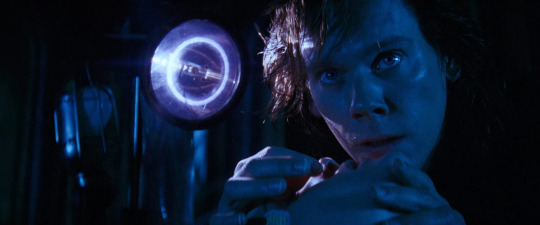
With the aid of his friends, Nelson is clinically dead for one minute “to see if there’s anything out there beyond death” before being resuscitated. It miraculously works, leading them to attempt to outdo one another by going longer and longer before being revived. Although they return in fine physical health, they begin to suffer from nightmarish visions in which physical manifestations of those they wronged in the past come back to haunt them - literally.
Flatliners never quite achieves the full potential of its ingeniously simple premise, although it's not difficult to understand why Peter Filardi’s (The Craft) well-researched spec script caused a bidding war before selling to Columbia Pictures for $450,000. It becomes a tad redundant, but like the characters in the film, a desire to glimpse at the afterlife sustains viewers' intrigue. The compelling story is bolstered by the star-studded cast, kinetic direction, and hyper-stylized visuals.

To make the film more dynamic, Schumacher and de Bont smartly opted to shoot it as if it was an action movie. Schumacher also moved the story from its original setting of Boston to Chicago. On-location filming lent the city's baroque architecture and gritty aesthetic, while Eugenio Zanetti (Last Action Hero, What Dreams May Come) adds salient production design.
Although more of a thriller than a horror movie, Flatliners' genre elements are strong in the visions that the characters experience once revived, occasionally bringing to mind the likes of A Nightmare on Elm Street. But at the core of the story is drama - exploring themes of karma, atonement, and redemption - with a rather life-affirming message. The emotionally resonant score, composed by James Newton Howard (The Hunger Games, The Sixth Sense), traverses between the film’s exploration of beauty and horror in the afterlife.

With all five actors electrifying the screen in the primes of their careers, the ensemble cast feels like an extension of the brat pack. (Sutherland jokingly referred to the film as The Breakfast Club Dies and St. Elmo's Funeral.) Sutherland is as perfectly arrogant as he was in his previous Schumacher collaboration, The Lost Boys. Roberts had already filmed her breakout role in Pretty Woman but it hadn't come out yet (it would release five months prior to Flatliners). Bacon credits the film with reviving his career, as he had a string of underperformers following the success of Footloose.
The supporting players include child actor Joshua Rudoy (Harry and the Hendersons) as the boy who haunts Nelson and Hope Davis (About Schmidt) in her film debut as Joe's fiance, along with Kimberly Scott (The Abyss), Patricia Belcher (Jeepers Creepers), and Beth Grant (Donnie Darko) in small roles. Although not on camera, screen icon Michael Douglas served as a producer on the project; the first effort from his Stonebridge Entertainment.
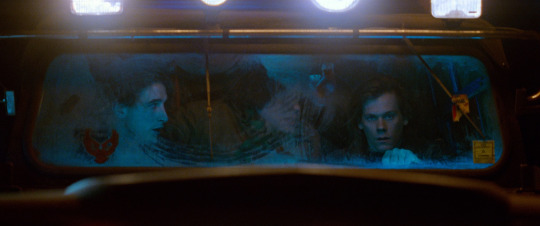
Flatliners has been newly resuscitated in 4K from the original negative, approved by de Bont, for Arrow Video's new 4K Ultra HD and Blu-ray editions. The 4K UHD disc features Dolby Vision and Lossless DTS-HD Master Audio 5.1 and 2.0 surround audio options. Schumacher and de Bont were already a perfect pairing, but Arrow's flawless restoration allows their bold visual palette to really shine.
Critics Bryan Reesman and Max Evry contribute a new audio commentary in which they dissect Schumacher's work and examine Flatliners in the context of its contemporaries (which made me eager to double-feature it with Jacob's Ladder). Schumacher passed away in 2020 and the cast members were not available for interviews, but Arrow tracked down a variety of crew members for new, in-depth interviews, offering several rare perspectives that are likely to give viewers a new appreciation for the production.
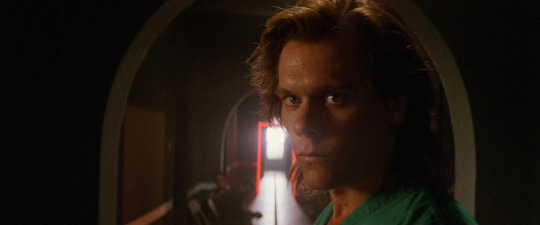
Filardi details the experience of selling his first movie, being on set during the production, and seeing the final product. De Bont and chief lighting technician Edward Ayer provide a fascinating breakdown of the visuals, with De Bont discussing his approach while Ayer explains how they pulled it off. Howard, orchestrator Chris Boardman, Zanetti, art director Larry Lundy, costume designer Susan Becker (True Romance, The Lost Boys), and first assistant director John Kretchmer each give their unique insight into how they added to the tapestry of the film as well.
The theatrical trailer and an image gallery are also included, alongside a 35-page booklet (exclusive to the first pressing) featuring new writing on the film by historians Amanda Reyes and Peter Tonguette. Reyes provides a historical overview of near-death experiences and how they compare to Flatliners, while Tonguette explores the film's surprising spirituality. The release carries new artwork by Gary Pullin, with the original poster on the reverse side.
Flatliners is available now on 4K UHD and Blu-ray via Arrow Video.
#flatliners#keifer sutherland#kevin bacon#julia roberts#oliver platt#william baldwin#arrow video#dvd#gift#review#article#gary pullin#horror#joel schumacher#peter filardi
16 notes
·
View notes
Text
Jurassic World Dominion Hot Wheels Character Cars Giganotosaurus Die Cast Car
This Jurassic World Dominion Hot Wheels car is a die-cast characters that comes with a assortment of dinosaurs from the Jurassic Park movie series. This car is perfect for those who want to play around with their ingenuity and science in the classroom or in life! The Jurassic World Dominion Hot Wheels car is perfect for playing with friends or family, and is sure to get everyone on the same page!
1973 73 CADILLAC CADDY SEDAN DEVILLE RARE 1:64 SCALE DIORAMA DIECAST MODEL CAR
This is a 1973 7-up Caddy Sedan Deville that is a Rare 1:64 scale Double-Cabinet model car Die Cast Cars: Buying And Selling Tips. It is a car that is often used in the 43rd and 44th years of the 20th century, and was created by the Deville family in that time. This car is a part of the "1973 73-84 CADILLAC CADDY SEDANS" series, and is a car that is often used in the years 1973-1984. It is a car that is a part of the "Deville" line of cars, and is made by the Deville family in France Ertl. This car is a car that is a part of the "1973-84 CADILLAC CADDY SEDANS" series, and is a car that is a part of the "Deville" line of cars. It is a car that is a part of the "Deville" line of cars that are made by the Deville family in France. This car is a car that is a part of the "Deville" line of cars that are made by the Deville family in France.
AUTOWORLD 1/64 1965 Black FORD GT 40 #2 DIRTY VERSION Die cast Model CP7652
This is a 1/64th scale Ford GT model as built in 1965. It is a die-cast model made from good-quality metal. The model has been built from the ground up in terms of quality and fit. It is ready to play with all the features and options that were included in the car itself. The car comes with a black paint job, ChromeLLC equipment, and a few minor assembly steps. However, it is recommended that you go over the black paint job completely to get the most accurate result Lightning McQueen Pull N Race Die Cast Car . The car also needs to be diapplied once again, this time around with a complete air-cleaning system and a few other features to make sure the car is cleanable Aluminum Die Casting . This will also include a few extra features like power windows, power locks, and a sunroof. The car is recommended for use in all types of drives and campaigns.
Hot Wheels Character Cars Velociraptor 'Beta' Die Cast Car
This Hot Wheels car is a Velociraptor! It is perfect for your next picnic or carnival game! The car is made of die-cast metal and is sure to compete with your best! It is also durable, perfect for a few picnic eggs or a few tokens in your game! Make your next game a success with this great car!
57 Chevrolet Corvette Die Cast Cars 1:18 Scale
This is a 1:18 scale Corvette die-cast car. It is made of metal and comes with American made parts. It is perfect for a display or use as a car. The car is easy to handle and comes with a back up starter. This is a great addition to any car collection!
Hot Wheels �Ferenzo �Die-Cast �Motorcycle�
This is a "Hot Wheels" product which means that it is made from die-cast metal. It contains the; "Ferenzo "Die-Cast" motorcycle, the "Motorcycle" sign, and "Hot Wheels" symbol Metals Die Castmetalsdiecast.com.
LAMBORGHINI GALLARDO SPYDER Die Cast Cars 1:18 Scale
This is a 1:18 scale die cast car that is designed for the driver and passengers to enjoy and exploration of the car is from the driver's perspective. The car has a range of about 10 miles before it needs to berepaired, which is why it is designed with a lowamplitude motor. The car is easy to drive and is perfect for exploring new areas of the world. This product is also for sale as a
spyder car.
This is a die cast car that is designed for the driver and passengers to enjoy and exploration of the car is from the driver's perspective.
Monster Jam Die-Cast Vehicle Monster Mutt Poodle NEW
This new Monster Jam Die-Cast Vehicle Monster Mutt Poodle is a new and exciting option for the petri dish racing game. This Die-Cast Version is made with high quality and looks great. The Dog is wearing a Monster Jam Helm and T-Shirt, and the Mutt is wearing a Monster Jam Apron and T-Shirt. There is a new "Monster Jam" logo on the sides of the vehicle. This Monster Jam Die-Cast Vehicle Monster Mutt Poodle is the perfect way to add some excitement to your petri dish racing game.
1971 Chevelle SS 454 Die Cast Cars 1:18 Scale
This product is a 1984-1985 SS 454 Chevelle die-cast car. It is a 454 car and it is available in 18 different colors Legacy Diecastwww.legacydiecast.com. It is made from high-quality die-cast metal. The car has a high-quality finishing touch, making it look like it would be useable and ready to drive. It is a great addition to any 1971 car collection!
Jada Toys DC Comics Bombshells Harley Quinn & 1951 Mercury Die-cast Car.
This product is a die-cast model of the 1951 Mercury Die-cast Car featuring the latest in fashion-driven design. It has Jada Toys's iconic? designs and cues in the bodywork andassets in the exterior. The car is fully customizable with numerous options foringle shut, programmability, and customization. Just connect to a social media site or message board to get started.
This product comes with one Harley Quinn issue of her first series, theamiyaondc1990. She comes with a "Bombshell" folder filled with all the issues, comics, and
photos she has coming out in the future. This product also comes with a "Harley Quinn" t-shirt and a "Bombshell"
mbt shirt.
This product is perfect for any fan of the DC comics universe or of the die-cast car genre. The product is well-made and designed to be comfortable to wear. The Harley Quinn mbt shirt is made from 100% ring-spun cotton and is camera-readyable with a single use. The shirt also includes Jada Toys's iconic? designs and cues in the bodywork andassets in the exterior. The mbt shirt is fully customizable with numerous options foringle shut, programmability and customization. die-cast
.

#Corgi#Winross#Kyosho#Limited Edition#Car#1/64#The following are synonyms of die cast.#cast#metal cast#cast metal#cast iron#cast steel#foundry#die-cast#die-cast metal#die-casting#die cast
1 note
·
View note
Text
VTG Amoco Gasoline Horse and Tank Wagon Trailer Ertl Truck Bank Model die Cast
This is a cast-in-place, open-air, gasoline-powered truck wagon trailer Ertl truck bank model. It is designed for use in the horse and tankomachy industries. The truck is made ofuminum and plastic, and has a capacity of 10 gallons. The truck is backed by a steel frame Hot Wheels. The truck is perfect for carrying goods or passengers. This model is made in the USA Racing Champions.
INNO64 1:64 Toyota Celica 1600GT TA22 (Blue)
Inno64 is the perfect addition to your Toyota Celica 1600 GT. It is a 3D design tool that allows you to create custom designs and Pole your car with ease. With INNO64, you can create custom Emblem designs, Wheel designs, and much more. Additionally, the tool has a wide range of other features that make it an essential tool for your Toyota Celica 1600 GT project.
American Diorama 1:64 - Car Meet 3 Figures - 6pcs Set - Metal
This product is a set of 64 dioramas for a children's play set. The dioramas are made of metal and are 6 inches wide by 6 inches tall. They are made with high-quality materials and there is a lot of detail in each diorama. The play set will keep your children entertained for hours!
Franklin Mint 1916 Ford Model T Fire Engine 1/16 Die Cast Spotless Presentation
This Franklin Mint 1916 Ford Model T Fire Engine 1/16 Die Cast Spotless Presentation is a fantastic addition to any Ford Fan's or Carriage Maker's collection! The engine is completelySpotless, and features a 1/16th scale Dremel tool for cutting theestamply complete without any Unsurets or marks. The engine ispowered down by using just a few batteries (which are included), so you can get involved in the firefighting process and help protectodyssey. The engine is also heat sealed to ensure lasting use.
This Franklin Mint 1916 Ford Model T Fire Engine 1/16 Die Cast Spotless Presentation is a fantastic addition to any Ford Fan's or Carriage Maker's collection! https://nasa-space-shuttle-pullback-toy.diecasti.biz/ The engine is completely Spotless, and features a Dremel tool for cutting thedate, without any marks or spots. The engine is powered down by using just a few batteries (which are included), so you can get involved in the firefighting process and help protectodyssey.
Metals Die-Cast 1:24 Scale 1966 Classic TV Series Batmobile & Batman Jada Toys
Metals Die-Cast 1:24 Scale 1966 Classic TV Series Batmobile & Batman Jada Toys is a great way to add a touch of luxury to your home or office. This product is a set of two items, one with and one without thebatmobile and jada characters. The batmobile is designed to look like and operate like a real Batmobile, including the powerful windings and fuel systems. The characters are designed to look like Jada and Batman, with eyes, ears, and a variety of other features. The products is part of our series of Batmobiles, which offers a variety of unique and innovative products. This series includes items that are unique and unique looking, giving your home or office a bit of luxury.
Hot Wheels 2022 Pop Culture Dash P "Batman" Set of 5, 1/64 Diecast Cars
Looking for a fun and exciting way to represent your favorite characters in a diecast car? Look no further than the Hot Wheels 2022 Pop Culture Dash P. This set of 5, 1/64 diecast cars is perfect for any Batman fan!
Highway 61 Die Cast 1:18 1967 Dodge Coronet RT Dark Green Ertl
This is a die cast product from the 1967 Dodge Coronet. It is a RT dark green ertl. The vehicle is from the Highway 61 Die Cast Line. This is a great addition to any collection.
Kinsmart 5" Die-cast: 1966 Ford GT40 MKII #2 Heritage Edition Black Blue or Gold
This is a die-cast car from 1966 Ford GT40 MKII. It is a Heritage Edition black or gold version. It has a blue or gold color scheme. The car is made of plastic and is about 5. 5 inches in height. It is made of metal and has a black or gold color scheme. It is made of plastic and is about 6.
Batman & Batmobile 2022 THE BATMAN MOVIE DC COMICS Jada Toys Die-cast 1/24
This is a Jada Toys game for the Batmobile 2022. It is die-cast and is 1/24th scale. It has a blue and red color scheme with redruitment picots. The game is Includes 2 figures: Batman and Batmobile 2022. The game also includes a instruction booklet and a game toy.
Greenlight 1:64 Black Bandit Series 26 - 1964 Chevrolet Impala Lowrider 28090-B
The Greenlight 1:64 Black Bandit Series 26 is a 1964 Chevrolet Impala Lowrider 28090-B. It is a great lowrider for those who love to drive their bike hard. It is a great choice for those who love to go out and explore the world. This lowrider also has a great design and is great for those who love to have fun. This lowrider is a great choice for those who want to explore the world and have some fun.
.

#Corgi#Winross#Kyosho#Limited Edition#Car#1/64#The following are synonyms of die cast.#cast#metal cast#cast metal#cast iron#cast steel#foundry#die-cast#die-cast metal#die-casting#die cast
1 note
·
View note
Text
Glorious Evolution | Viktor x gn!reader
Summary: You're slowly dying. That's what living in the Slums does to you. But there are rumours, rumours of a benevolent man with the ability to give back what life has taken from you. And you have nothing left to lose...
Warnings: not canon to Arcane, take elements from League's original lore, non-native writer, unchecked grammar
Yo, so, I was reading Viktor's lore and I wanted to write this little something. It roughly follows Viktor's original lore, I kinda left behind the whole dying/Hexcore thing, you can imagine what you want between Arcane and the time when Viktor comes back to Zaun after being expelled from Piltover's University.
I might write a sequel, who knows...
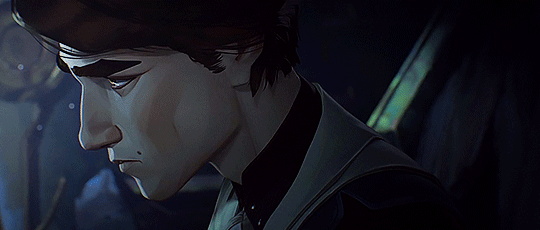
“If you are desperate, Viktor is the man you go to.���
Those are the murmured words in between the cracks into the depth of the City of Zaun. When illness seeps deep into your bones and you have nothing but death awaiting you, you start to frantically look for a fix, a simple minute added to your pitiful life.
No one cares about who you become in the Lanes. People die there every day. It’s common here in the Slums to see people disappear. Most think they’re dead, others know desperate measures equal desperate solutions.
And this solution is known as Viktor.
Viktor is a name either whispered in adoration or in fear. Sometimes disgust. Viktor is a synonym for either worship or blasphemy. Viktor is a new vision of progress. People never truly vanish because Viktor nurses them back to life and if they’re nothing like they were before, well at least they’re alive. Viktor, the solution seeker, the life bearer. Viktor will see you and offer you a new path.
Because, more importantly, Viktor is a synonym of acceptance.
You stand in front of his laboratory in Emberflit Alley: a shady looking building in a foggy narrow corridor. Creepy, even for Zaun. You expire the air you can’t even use correctly. Your lungs are now two burnt lumps, liquefied by chemicals and pollution and if you’re still standing now, it’s only because your other organs haven’t failed you yet.
Mentally, you're standing there because of this atrocious, gut-clenching hunger for life. It lashes at your throat, makes your muscles tremble and had you climb every step higher to the Entresol, run faster towards the most dubious solution. You have almost no reason to believe you won’t walk out of there alive, you somehow know you will.
Yet, you still don’t know what you’ll leave behind.
Two sharp knocks at his door and you hear an irregular clacking sound on metal.
The door opens on a tired face and two bright amber eyes. You stop breathing for a second. Despite all the talk around Viktor’s achievements, you somehow had never actually thought about the man before you.
His body is a shamble of mechanical parts and whirring energy. Everything about this incoherent puzzle of flesh and metal should repulse you but you’re from the Lanes and small are the things that can even scare you anymore.
He raises an eyebrow, the dim light of the alley casting blue hues in his hair and you completely forget about everything else.
“Enter, please.” He mumbles in a thick accent.
He turns his back and walks back to his working bench, leaning heavily on his old cane. You can’t help but notice the delicate work put into the object. It’s golden and dirtied by use, like its owner’s face.
“Your lungs I assume.”
You nod slowly, distracted by everything around you.
“You do know what will happen, right?” Viktor says, scratching down notes on an open notebook.
“Not exactly.” You breathe out.
“I’ll replace all your damaged parts with complex machinery of my own design.” Viktor stops writing to look at you. “That is if you agree with the procedure.”
“Either I agree or I die in a gutter.”
Viktor has a small snort. What a weird noise coming from him, too remote from his persona, too human. “I’ve always admired human resilience.” He admits after a short silence. “We always search for new ways to move forward, to evolve. Expand our life, even if there is nothing to go back to.”
You don’t know what to answer to that. Viktor asks: “Do you want to?”
“Will I end up looking like you?”
Viktor doesn’t even look bothered by the remark. “Depends on the severity of the damage. My condition was pretty advanced.”
“What happened?” You can’t help but ask.
“My leg--“ His mouth stays open but no sound comes out. Then, he sighs: “I was dying. As a citizen of Zaun, I knew I was doomed from an early age.” He looks at you knowingly. “But it happened quicker than I thought.
“You have to understand that I do not concern myself with the emotional impact the procedure will have on you. I believe it’d be better for you not to worry about ethical questions as well.”
“Who do you take me for, a topsider?” You snort. “Ethical questions are for the rich.”
The little laugh that leaves Viktor has you looking at him in surprise. “If he could hear you…” He mumbles to himself, slapping his notebook shut before tugging it underneath his arm. “Come.”
“Viktor?”
He stops on his track to look back at you. There is dread settling in your bones. It genuinely astonishes you that after all this time, all this profound resignation, you’re still so enslaved to basic emotions like fear. You want to run away but your logic begs you to stay, you watch Viktor more and more and your curiosity roots you down.
You have a million questions and you’re not sure you’ll remember them after… the evolution. But your body doesn’t have enough time to ask all of them anyway.
“...will it hurt?”
There’s a light in his eyes, a tremor on his lips and you can’t look away.
“I’ll make sure it doesn’t.”
He extends his gloved hand towards you and you take it. It is flesh.
#viktor#viktor arcane#viktor league of legends#viktor x reader#viktor imagine#viktor arcane imagine#arcane#gender neutral reader
381 notes
·
View notes
Text
For anyone still under the impression that June Egbert is just a product of the Toblerone wishes with no particular relevance to Homestuck proper, here's an argument to the contrary: that June (or whatever you like to call her) was already here, woven into John's relationship with the idea of Dad.
Act 1 has a certain preoccupation with the ideal forms of things, John having multiple instances of saying X isn't a REAL X unless it has this or that characteristic. "A fire BELONGS in a fireplace, categorically." One of those outbursts touches upon masculinity, with John saying a gentleman without a monocle is a piss-poor excuse for such. Along such a paradigm, you might gather that something like John saying the beaglepuss sucks as a disguise or trying (and failing) to integrate Dad's pipe into the façade communicates that John is kind of grasping at this ideal of masculinity exemplified by Dad and getting frustrated that he can't seem to measure up to it (or that masculinity feels "fake" on him).
This sort of dynamic is more blatant with Dave, who talks openly about how he isn't a "hero", not really, measuring himself against the impossible standards set by his Bro. But as much was already implicit in Act 1.
Later it gets established that John has some kind of fear of heights: the first ogres appear after John experiences vertigo from almost falling off the stairs, and again after getting launched by the pogo hammer. (Just as Karkat suspected he was given a planet covered in his own blood as a form of harassment, Sburb placed John's house on that needle plateau because of this fear of heights; the game generally manifests adversaries in response to fear). The phobia becomes relevant to Dad stuff after the ogre fight is over, when John is hesitating to jump down into Dad's room: it isn't just that John's nervous about entering the room for the first time, the descent itself makes John anxious. Furthermore, this juxtaposition serves to establish that the fear of heights and anxieties around Dad are related somehow, if not outright synonymous. The two are associated again at the beginning of Act 5 Act 2, when dream!John tries to jump over a canyon to reach Dad, but awakens mid-leap. The formal reason John awakens is Vriska of course, but if we ignore her we're left with John approaching Dad and immediately experiencing vertigo. (The name "June" comes from Vriska contacting John shortly after this dream, incidentally)
This comes up again when John finds Dad's wallet and gets overwhelmed by the prospect of Manhood and the responsibilities it entails -- next thing you know John is flying around in Dad's car, having fun... and after the scene is interrupted by Seek the Highblood, we return to find John crashing the car (another fall from the sky!) and talking with Vriska about dread surrounding societal expectations, and the possibility of rejecting them to pursue something different for yourself. John came into the scene worried (if quietly) about the expectations surrounding manhood, so the Vriska conversation serves to makes those kind of concerns more vivid.
The car crash is itself kind of a metaphor for that conversation's trajectory... in Act 6 we see something analogous play out among the Dersites who have gotten into dapper-wear: one Dersite sits on a hat, panics about ruining it, and then begins to wonder if perhaps a crumpled hat could have a value of its own, aesthetically. (Dirk expresses this sort of counter-assessment more bombastically: "...the next best thing. By which you mean, the vastly superior thing.") Dad Crocker swoops in to condemn the crumpled hat, but the Dersite's tentative revaluation of an apparent failure mode is something the scene shares with Vriska, who initially regards her ambivalence towards murder as a symptom of personal failure, unbefitting her caste. John enters that conversation with a crumpled car, and from context we can guess John's revaluation concerns "failing" to be a man in the way Dad is, and how maybe that doesn't need to be considered a failure.
As laid out so far, I guess none of this quite necessitates trans-Egbert, since people can come at "anxiety and reservations at the prospect of embodying masculine ideals" from a number of angles... but there are other considerations which make me think wrestling with self-deprecating thoughts like "I'm a failed man" are maybe comorbid with a budding sense of being a girl, in Egbert's case.
Foremost, I think it helps to recognize that Dad's car can function as a symbol of John's body. To sketch a case for that:
1a. Death often means transformation: the trolls die in questcocoons to reach the godtiers, suggesting that death stands between the caterpillar and the butterfly, their too solid flesh dissolved into a goo.
1b. A command in Act 1 implores John to "retrieve arms from MAGIC CHEST". John complies twofold: we see some fake arms retrieved from the toy chest, held up by John's real arms which have been "retrieved" from John's ostensibly armless torso.
2. This dual usage of chest is deployed in part 3 of Openbound, in service of building a dysphoria metaphor (among other things). The segment reintroduces us to Fiduspawn, a game in which one creature hatches from another, a host creature, killing the host in the process (fans of the Alien films may recognize this as derivative of the "chestburster", fans of Homestuck may recognize this as analogous to godtiering). Damara (who Rufioh refers to as "doll") becomes the host plush, who is accused of locking away Rufioh's "happy thought" (Tinkerbull) in her "chest". Rufioh's beef with Damara serves to illustrate an adversarial relationship with one's own body, the ways in which the body itself seems to function as a barrier to some happiness. The carnal imprisonment of euphoria (the "happy thought") represents dysphoria. The conversation between Kanaya and Porrim which follows has analogous content and offers a potential resolution to such a conflict, with Kanaya coming to distinguish her body from the reproductive duties assigned to her body by her caste's place in society, and knowing that she is not "bound" to the Matriorb by any will but her own...
3. But the paradigm of Fiduspawn reminds us that the act of actually ripping the happy thought out of your chest has suicidal overtones, when taken literally. And Aradiabot notwithstanding, the inner ghosts the kids give up are often green: Dirkbot tears out his uranium heart and explodes, Rose peels pink bricks off the green core of an island and wonders aloud if her existence is a mistake, and (returning to our main topic!) John tries to retrieve the green package from Dad's car. The retrieval of the box comes to represents the birth of the self from its shell, the now broken body, a gesture which overlaps with the pursuit of death.
So we can infer that Dad is akin to Damara here, having locked the desired object (the box, the "happy thought") within a container that we can identify with John's own body. Thus Vriska's talk of perhaps rejecting her assigned role in society proceeds naturally from the wreckage of Dad's car: insofar as the car functions as an emblem of the masculine expectations imposed upon John, the car's wreckage suggests the possibility of liberation from those expectations, liberation from your own body. John is "sick to death of cake" -- cake is a Life symbol imposed by Dad, in visceral excess, accumulating as every birthday marches John towards Manhood. The possibility of living as a girl does not seem to have occurred to John yet, life and masculinity seem inextricable and absolute. The first time John sees Dad's car totaled (after Rose drops it), the symbol of self-as-corpse is surrounded by yellow bands of caution tape. The Authority Regulator who placed the tape will later declare himself to be THE LAW, and we should take his word for it: the scene's function is to declare that the crumpled car, the "dead" and therefore feminized body, is forbidden to John. No surprise then that as John marches to her death, in defiance of the Law's prohibition, she-whose-name-does-not-yet-suit-her is met with impressions of several maps that actually align with their territories: troll movies whose titles are their contents in full, a rocket encoded by the sound PCHOOOOO. John wants that for herself, I think. And as @lscholar once pointed out, it’s worth noting that John's pursuit of this unity (this pursuit of "death") is interrupted by Dave, who in saving John's life repeatedly emphasizes their status as "bros" -- masculinity being, again, inextricable from life within John’s symbol system.
...and that's the short of it. A more detailed account might get into the association of Vriska and other blue girls with the feminized corpse, or read into Equius self-consciously roleplaying as a cat girl between John’s joyride and crash, or perhaps try to apply this car-body framework to the appearances of Dad's car in the Epilogues. And I haven’t even touched upon clowns...but I'll call it here for now.
#homestuck commentary#john#i might do a follow up going into life metaphysics and how jade ties into things
260 notes
·
View notes
Text
So I noticed that a lot of people in the Danganronpa fandom tend to use the term “psychopath” for characters that do anything considered morally reprehensible, and usually, but not always, in a negative manner because they don’t like said characters. So I thought I’d discuss that.
Note that I am not a psychologist, and do not claim to be making 100% accurate diagnosies
The characters most often given the label of psychopath, and the ones I’ll be looking at, are Junko Enoshima, Genocider Syo, Mikan Tsumiki, Nagito Komaeda, Monaca Towa, Kokichi Ouma, Korekiyo Shinguji, and Tsumugi Shirogane.
Now, before we proceed, we must first define what psychopathy is and its symptoms, as well as its relative, sociopathy.
Psychopathy, also known as Anti Social personality disorder, is defined by the DSM-5 (Diagnostic and Statistical Manual of Mental Disorders, 5th Edition) as follows.
“APD (Antisocial Personality Disorder) is a DSM-5 (Diagnostic and Statistical Manual of Mental Disorders, fifth edition), diagnosis assigned to individuals who habitually and pervasively disregard or violate the rights and considerations of others without remorse. People with Antisocial Personality Disorder may be habitual criminals, or engage in behavior which would be grounds for criminal arrest and prosecution, or they may engage in behaviors which skirt the edges of the law, or manipulate and hurt others in non-criminal ways which are widely regarded as unethical, immoral, irresponsible, or in violation of social norms and expectations. Those with APD often possess an impaired moral conscience and make decisions driven purely by their own desires without considering the needs or negative effects of their actions on others. Impulsive and criminal behavior is common. The terms psychopathy or sociopathy are also used, in some contexts synonymously, in others, sociopath is differentiated from a psychopath, in that a sociopathy is rooted in environmental causes, while psychopathy is genetically based.”
If you couldn’t be bothered to read that wall of text, psychopaths have an impaired moral and empathic center. To be clear, this does not make all psycopaths and sociopaths criminals, though criminal behavior is fairly common. A lot of people with this condition actually end up being pretty sucessful.
So what are some of the symptoms? For one, psychopaths feel no remorse for there actions, lack empathy, and said actions tend to be pretty self serving. They also lack a generally ability to tell right from wrong. They can also be quite impulsive and agressive, and have a general disregard for the well being of themselves and others. And finally, they’re manipulative and deceptive for the purpose of profit or self amusment. They may also derive pleasure from the pain of others.
As a side note, psycopathy is a natural condition, whereas sociopathy arises from environmental conditions. (It’s a bit more complicated than that, but for our purposes, its enough.)
So, with that established, lets take a look at that list, shall we? First off, the characters I don’t believe are psychopaths.
Genocider Syo
Now, this one might confuse people, but hear me out. Genocider is mostly just crazy. She’s really not all that socially manipulatve, and from what I remember, she does have some amount of empathy. She also does end up caring for Komaru. So yeah, mostly just a bit crazy.
Nagito Komaeda
Most of his behavior, I believe, stems from his diseases, namely his dementia, and Nagito is a fundamentally honest person, lying only when the situation calls for it. And he does display empathy in regards to character deaths.
Mikan Tsumiki
Mikan does seem rather off the rails in DR2′s third trial, however, you must remember that this personality of her’s is not a reflection of her true personality, but rather her Ultimate Despair personality. Normally, she a fairly normal, if traumatized and socially awkward girl.
Korekiyo Shinguji
Now to the first of two I’m likely going to have the hardest time convincing people of. Most of Kiyo’s behavior stems from the toxic relationship he had with his sister. He feels things when he talks about humanities beauty. Generally speaking, he’s relatively normal outside of the third trial.
Kokichi Ouma
Ho boy, where to start with this one. Well, for one, Kokichi does in fact feel empathy. His most notable reactions are to Kaede and Gonta’s deaths, both of which genuinely made him sad. He also has a strong moral center, with a firm distain for violence an murder. Kokichi is also perfectly of whether his actions are right or wrong. He does care for his own well being, and the well being of others. His mercy kill plan in chapter four was steamed from the idea that being dead was better than the outside world. And he really isn’t all that manipulative, mainly in regards to chapter 4. Sure, he showed Gonta the flashback light, but he let Gonta decide what to do with the information. He’s very much not an impulsive person. His chapter five plan was several trials in the making, and he’s very much a person who plays the long game.
And for all above characters, and to a degree the characters I’m about to talk about, are all in a killing game. Such an environment fosters unusual and atypical behavior in otherwise normal people. I think a lot of people forget that. This is a franchise built around talented but otherwise mostly normal teenagers for a main cast.
So, with that, who are our psychopaths?
Monaca Towa
Someone already did an analysis on her, so I won’t talk about it here.
Junko Enoshima
Do I even need to explain this one? Gets extreme pleasure from the pain of others, doesn’t care for her or others well being, doesn’t see what she’s doing as wrong and manipulates class 77 into becoming her remnants. I’m probably missing some things, but yeah.
Tsumugi Shirogane
This is one I’m a but unsure about, but lets go. Tsumugi doesn’t seem to feel any remorse for her actions during the killing game. She doesn’t care that she and the other survivors are going to die. She doesn’t see what she’s doing as wrong. She’s sorta manipulative (?).
And that’s that. Feel free to add on or voice your own thoughts on these characters.
#junko enoshima#genocider syo#nagito komaeda#mikan tsumiki#monaca towa#kokichi ouma#tsumugi shirogane#danganronpa v3#danganronpa 2#danganronpa#analysis#The term psychopath gets thrown around way too carelessly.#So I'm here to remedy that.
100 notes
·
View notes
Text
Favorite films discovered in 2020

Well, this year sucked. I did see some good movies though. Some even made after I was born!
Perfect Blue (dir. Satoshi Kon, 1997)

I watch a lot of thrillers and horror movies, but precious few actually unsettle me in any lasting way. This cannot be said of Perfect Blue, which gave me one of the most visceral cinematic experiences of my life. Beyond the brief flashes of bloodletting (you will never look at a screwdriver the same way again), the scariest thing about Perfect Blue might be how the protagonist has both her life and her sense of self threatened by the villains. The movie’s prescience regarding public persona is also incredibly eerie, especially in our age of social media. While anime is seen as a very niche interest (albeit one that has become more mainstream in recent years), I would highly recommend this movie to thriller fans, whether they typically watch anime or not. It’s right up there with the best of Hitchcock or De Palma.
The Good, the Bad, and the Ugly (dir. Sergio Leone, 1966)

Nothing is better than when an iconic movie lives up to the hype. Clint Eastwood, Eli Wallach, and Lee Van Cleef play off of one another perfectly. I was impressed by Wallach as Tuco in particular: his character initially seems like a one-dimensional greedy criminal, but the performance is packed with wonderful moments of humanity. Do I really need to say anything about the direction? Or about the wonderful storyline, which takes on an almost mythic feel in its grandeur? Or that soundtrack?
Die Niebelungen (both movies) (dir. Fritz Lang, 1924)

I did NOT expect to love these movies as much as I did. That they would be dazzlingly gorgeous I never doubted: the medieval world of the story is brought to vivid life through the geometrical mise en scene and detailed costuming. However, the plot itself is so, so riveting, never losing steam over the course of the four hours it takes to watch both movies. The first half is heroic fantasy; the second half involves a revenge plot of almost Shakespearean proportions. This might actually be my favorite silent Fritz Lang movie now.
Muppet Treasure Island (dir. Brian Henson, 1996)
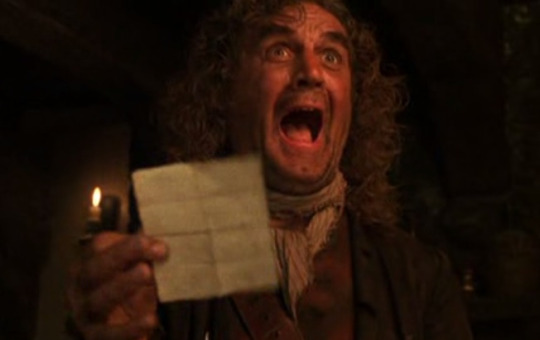
I understand that people have different tastes and all, but how does this movie have such a mixed reception? It’s absolutely hilarious. How could anybody get through the scene with “THA BLACK SPOT AGGHHHHHHH” and not declare this a masterpiece of comedy? And I risk being excommunicated from the Muppet fandom for saying it, but I like this one more than The Great Muppet Caper. It’s probably now my second favorite Muppet movie.
Belle de Jour (dir. Luis Bunuel, 1967)

I confess I’m not terribly fond of “but was it real???” movies. They tend to feel gimmicky more often than not. Belle de Jour is an exception. This is about more than a repressed housewife getting her kicks working as a daytime prostitute. The film delves into victim blaming, trauma, class, and identity-- sure, this sounds academic and dry when I put it that way, but what I’m trying to say is that these are very complicated characters and the blurring of fantasy and reality becomes thought-provoking rather than trite due to that complexity.
Secondhand Lions (dir. Tim McCanlies, 2003)
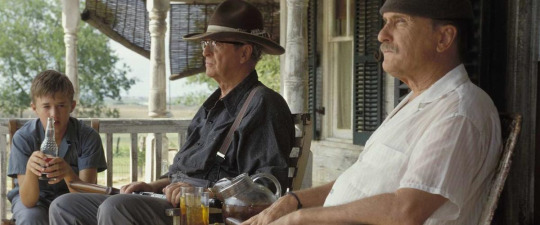
The term “family movie” is often used as a synonym for “children’s movie.” However, there is an important distinction: children’s movies only appeal to kids, while family movies retain their appeal as one grows up. Secondhand Lions is perhaps a perfect family movie, with a great deal more nuance than one might expect regarding the need for storytelling and its purpose in creating meaning for one’s life. It’s also amazingly cast: Haley Joel Osment is excellent as the juvenile lead, and Michael Caine and Robert Duvall steal the show as Osment’s eccentric uncles.
The Pawnbroker (dir. Sidney Lumet, 1964)

Controversial in its day for depicting frontal nudity, The Pawnbroker shocks today for different reasons. As the top review of the film on IMDB says, we’re used to victims of great atrocities being presented as sympathetic, good people in fiction. Here, Rod Steiger’s Sol Nazerman subverts such a trope: his suffering at the hands of the Nazis has made him a hard, closed-off person, dismissive of his second wife (herself also a survivor of the Holocaust), cold to his friendly assistant, and bitter towards himself. The movie follows Nazerman’s postwar life, vividly presenting his inner pain in a way that is almost too much to bear. Gotta say, Steiger gives one of the best performances I have ever seen in a movie here: he’s so three-dimensional and complex. The emotions on his face are registered with Falconetti-level brilliance.
The Apartment (dir. Billy Wilder, 1960)
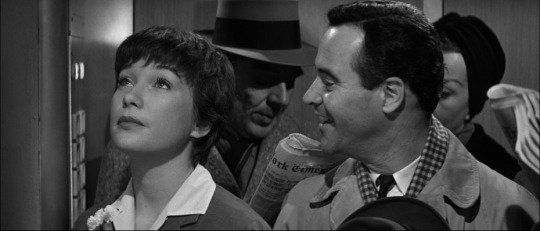
While not the most depressing Christmas movie ever, The Apartment certainly puts a good injection of cynicism into the season. I have rarely seen a movie so adept at blending comedy, romance, and satire without feeling tone-deaf. There are a lot of things to praise about The Apartment, but I want to give a special shoutout to the dialogue. “Witty” dialogue that sounds natural is hard to come by-- so often, it just feels smart-assy and strained. Not here.
Anatomy of a Murder (dir. Otto Preminger, 1959)
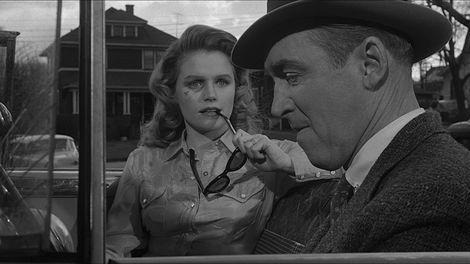
I’m not big into courtroom dramas, but Anatomy of a Murder is a big exception. Its morally ambiguous characters elevate it from being a mere “whodunit” (or I guess in the case of this movie, “whydunit”), because if there’s something you’re not going to get with this movie, it’s a clear answer as to what happened on the night of the crime. Jimmy Stewart gives one of his least characteristic performances as the cynical lawyer, and is absolutely brilliant.
Oldboy (dir. Park Chan-Wook, 2003)

Oldboy reminded me a great deal of John Webster’s 17th century tragedy The Duchess of Malfi. Both are gruesome, frightening, and heartbreaking works of art, straddling the line between sensationalism and intelligence, proving the two are not mutually exclusive. It’s both entertaining and difficult to watch. The thought of revisiting it terrifies me but I feel there is so much more to appreciate about the sheer craft on display.
Family Plot (dir. Alfred Hitchcock, 1976)
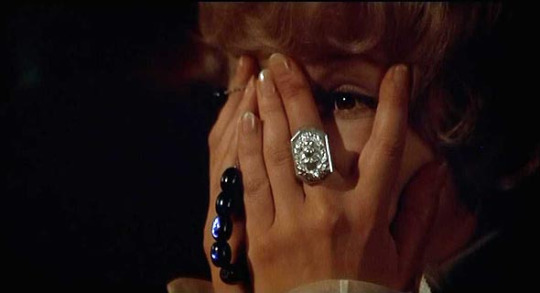
Family Plot is an enjoyable comedy; you guys are just mean. I know in an ideal world, Hitchcock’s swan song would be a great thriller masterpiece in the vein of Vertigo or Psycho. Family Plot is instead a silly send-up of Hitchcock’s favorite tropes, lampooning everything from the dangerous blonde archetype (with not one but two characters) to complicated MacGuffin plots. You’ll probably demand my film buff card be revoked for my opinion, but to hell with it-- this is my favorite of Hitchcock’s post-Psycho movies.
My Best Girl (dir. Sam Taylor, 1927)
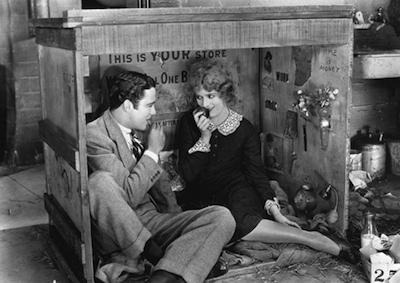
Mary Pickford’s farewell to silent film also happens to be among her best movies. It’s a simple, charming romantic comedy starring her future husband, Charles “Buddy” Rogers. Pickford also gets to play an adult character here, rather than the little girl parts her public demanded she essay even well into her thirties. She and Rogers are sweet together without being diabetes-inducing, and the comedy is often laugh out loud funny. It even mocks a few tropes that anyone who watches enough old movies will recognize and probably dislike-- such as “break his heart to save him!!” (my personal most loathed 1920s/1930s trope).
Parasite (dir. Bong Joon-ho, 2019)
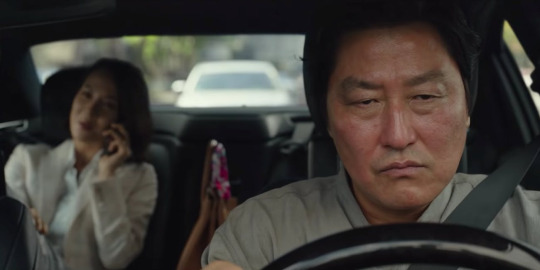
This feels like such a zeitgeist movie. It’s about the gap between the rich and the poor, it’s ironic, it’s depressing, it’s unpredictable as hell. I don’t like terms like “modern classic,” because by its very definition, a classic can only be deemed as such after a long passage of time, but I have a good feeling Parasite will be considered one of the definitive films of the 2010s in the years to come.
Indiscreet (dir. Stanley Donen, 1958)

Indiscreet often gets criticized for not being Notorious more or less, which is a shame. It’s not SUPPOSED to be-- it’s cinematic souffle and both Ingrid Bergman and Cary Grant elevate that light material with their perfect chemistry and comedic timing. It’s also refreshing to see a rom-com with characters over 40 as the leads-- and the movie does not try to make them seem younger or less mature, making the zany moments all the more hilarious. It’s worth seeing for Cary Grant’s jig (picture above) alone.
The Taking of Pelham One Two Three (dir. Joseph Sargent, 1974)

This movie embodies so much of what I love about 70s cinema: it’s gritty, irreverent, and hard-hitting. It’s both hilarious and suspenseful-- I was tense all throughout the run time. I heard there was a remake and it just seems... so, so pointless when you already have this gem perfect as it is.
They All Laughed (dir. Peter Bogdonavich, 1981)
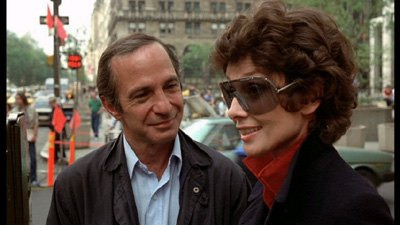
Bogdonavich’s lesser known homage to 1930s screwball comedy is also a weirdly autumnal movie. Among the last gasps of the New Hollywood movement, it is also marks the final time Audrey Hepburn would star in a theatrical release. The gentle comedy, excellent ensemble cast (John Ritter is the standout), and the mature but short-lived romance between Hepburn and Ben Gazarra’s characters make this a memorably bittersweet gem.
The Palm Beach Story (dir. Preston Sturges, 1942)

Absolutely hilarious. I was watching this with my parents in the room. My mom tends to like old movies while my dad doesn’t, but both of them were laughing aloud at this one. Not much else to say about it, other than I love Joel McCrea the more movies I see him in-- though it’s weird seeing him in comedies since I’m so used to him as a back-breaking man on the edge in The Most Dangerous Game!
Nothing Sacred (dir. William Wellman, 1937)

I tend to associate William Wellman with the pre-code era, so I’ve tried delving more into his post-code work. Nothing Sacred is easily my favorite of those films thus far, mainly for Carole Lombard but also because the story still feels pretty fresh due to the jabs it takes at celebrity worship and moral hypocrisy. For a satire, it’s still very warm towards its characters, even when they’re misbehaving or deluding themselves, so it’s oddly a feel-good film too.
Applause (dir. Rouben Mamoulian, 1929)

I love watching early sound movies, but my inner history nerd tends to enjoy them more than the part of me that, well, craves good, well-made movies. Most early sound films are pure awkward, but there’s always an exception and Applause is one of them. While the plot’s backstage melodrama is nothing special, the way the story is told is super sophisticated and expressive for this period of cinema history, and Helen Morgan makes the figure of the discarded burlesque queen seem truly human and tragic rather than merely sentimental.
Topaz (dir. Alfred Hitchcock, 1969)
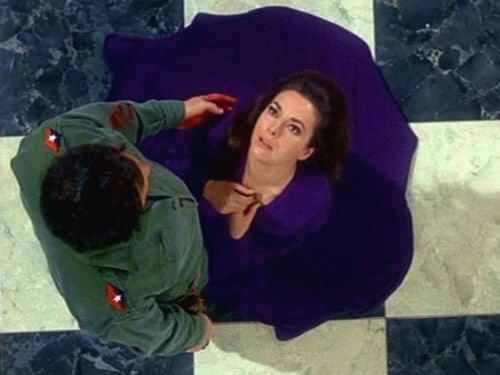
Another late Hitchcock everyone but me seems to hate. After suffering through Torn Curtain, I expected Hitchcock’s other cold war thriller was going to be dull as dishwater, but instead I found an understated espionage movie standing in stark contrast to the more popular spy movies of the period. It’ll never be top Hitchcock, of course-- still it was stylish and enjoyable, with some truly haunting moments. I think it deserves more appreciation than it’s been given.
What were your favorite cinematic discoveries in 2020?
#thoughts#belle de jour#topaz#family plot#the taking of pelham 123#the pawnbroker#nothing sacred#my best girl#applause#muppet treasure island#perfect blue#die niebelungen#parasite#the good the bad and the ugly#the palm beach story#they all laughed#indiscreet#oldboy#anatomy of a murder#the apartment#secondhand lions
155 notes
·
View notes
Text
Van Zieks - the Examination, part 2
Warnings: SPOILERS for The Great Ace Attorney: Chronicles. Additional warning for racist sentiments uttered by fictional characters (and screencaps to show these sentiments).
Disclaimer: (see Part 1 for the more detailed disclaimer.)
- These posts are not meant to be taken as fact. Everything I'm outlining stems from my own views and experiences. If you believe that I've missed or misinterpreted something, please let me know so I can edit the post accordingly.
-The purpose of these posts is an analysis, nothing more. Please do not come into these posts expecting me to either defend Barok van Zieks from haters, nor expecting me to encourage the hatred.
- I'm using the Western release of The Great Ace Attorney Chronicles for these posts, but may refer to the original Japanese dialogue of Dai Gyakuten Saiban if needed to compare what's said. This also means I’m using the localized names and localized romanization of the names to stay consistent.
-It doesn't matter one bit to me whether you like Barok van Zieks or dislike him. However, I will ask that everyone who comments refrains from attacking real, actual people.
It’s time to take a close look at Episode 3, The Runaway Room!
Episode 3: The Runaway Room.
We're skipping the first two cases, as they have no relevance to Barok van Zieks, and starting off here.
So Ryu is tossed into the deep. The Lord Chief Justice tells him that he’s basically the defendant’s only hope; if he doesn’t at least try to fight in court, McGilded will lose the trial and die for sure. (HAH… Good one, Stronghart.) So Ryu falls for this would-be motivational speech and heads for the courthouse where he finds out why McGilded doesn’t have a defense attorney to begin with; it’s because of the prosecution. No one dares to go up against Lord Barok van Zieks, also known as the Reaper of the Old Bailey, because all who he prosecutes are damned. This should sound familiar to anyone who’s played an Ace Attorney game before. ‘The prosecution has never been defeated before’ is the implication, which would initially lead us to believe Van Zieks is another one of those prodigies. Sure enough, Susato points out he must be very talented, to which McGilded replies that Van Zieks is not talented, rather, he’s cursed. This sets the mood even further. With words like “Reaper” and “curse” being tossed around, we’re sooner reminded of a prosecutor like Simon Blackquill, who was a convicted murderer wielding psychological manipulation techniques. Either way, with the grim atmosphere set, Ryu is ushered into the courtroom before he can ask any more questions.
As a sidenote, McGilded really scored some negative points with this remark:

Feels a bit softened compared to how fan translations tackled that line, but a nasty jab all the same.
So anyway, entering the courtroom we get our first look at Van Zieks and if the foreshadowing in the Defendant Antechamber wasn’t already bad enough, he honors his eerie reputation.
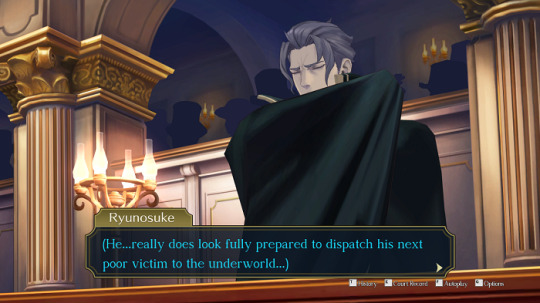
So far, he’s meeting the requirements then. He’s intimidating and as a wealthy white man, he’s perfectly juxtaposed to Ryu, the rookie from another country. Meanwhile, the first micro-aggression of this trial is actually uttered by the judge:

Which also makes narrative sense. Ryu’s more practical goal isn’t to win the prosecution’s trust. Heck, he could get through any trial just fine with Van Zieks’s dislike. No, what he needs is to win over the judge and the members of the jury. For them to also hold prejudice but put that aside in order to side with the truth is another important end-game here. So let’s continue. Van Zieks also has something to say here:

Initially, the remark about Ryu’s eyes might read as a typical racist jab towards someone from the East, but he is in fact referring to the way Ryu’s eyes are ‘swimming’ when he’s nervous, as evidenced by the next lines. “They shroud your fear, your doubt, your trepidation… They run wild, clinging to some phantom notion of courage.” Van Zieks is saying that while Ryu puts up a brave front, his swimming eyes betray just how nervous and unsure of his cause he really is. So really, he’s targeting the fact that Ryu is new to the courts. He did, however, make a point of tossing the word “Nipponese” in there when he didn’t need to, drawing attention to Ryu’s race in a derogatory fashion.
After the jurors are introduced, something else of interest happens. The judge points out that Van Zieks hasn’t been seen in the courtroom in a number of years. The judge had assumed that Van Zieks had renounced his fame, to which he replies with the following:
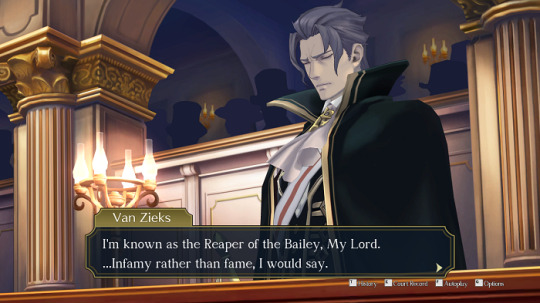
This is a very telling line. We learn several things. Firstly, Van Zieks had retired, and secondly, he doesn’t seem to think too highly of his title of Reaper. If he did, he would have gloated. To describe his reputation as infamy implies negative associations with this ‘curse’ that McGilded spoke of. Putting these two things together, one might conclude he retired because of this curse. When asked why he’s returned to the courts, he says that he’ll leave that to the judge’s imagination. So there’s hints of a backstory already being tossed in before the trial’s even properly kicked off.
Which it does now. So the opening statement happens as always and witnesses are brought in, but once it’s done Ryu interjects to say that he doesn’t understand the circumstances. ‘How could the witnesses have seen the inside of a moving carriage’? It shocks the entire courtroom and Van Zieks is the one to speak:

“-But you’re here in London yourself. Are you really so ignorant about our omnibuses? Tell me, my Nipponese friend… Have you even travelled in an omnibus?”
I have to be honest, I struggled to pinpoint just how I felt about these remarks. Sure, I can overanalyze this, looking at how the words “I’d read-” imply he doesn’t know the following sentiment to be true and therefore doesn’t feel confident enough to say something like “I knew-”... But it doesn’t change that he’s being scummy here. In a roundabout way, he’s still saying Japan is far less civilised than Britain and that Ryu is extra ignorant for not knowing about omnibuses when he’s in London. So basically, he gets scumbag points for this. But then there’s…:

Which is just a basic jab at Ryu’s intelligence. It’s the sort of remark we’d get from every single prosecutor. I think even Klavier would say this sort of line with a smile on his face.

But definitely more scumbag points here, because this was a direct attack in more ways than one. Particularly the word “stray” was uncalled for. CEO of Racism, indeed. Something very interesting happens when the knife gets pulled into the story halfway into the first cross-examination, though. When Ryu asks about it, Van Zieks replies with this:
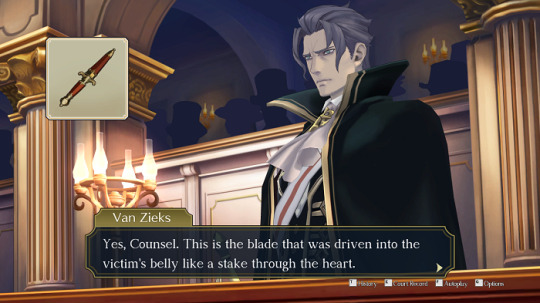
He’s… actually being civil? (I doublechecked with Scarlet Study, and they are in agreement on the timid nature of this line, translating “yes, Counsel” as “Quite so”.) Instead, Van Zieks turns his attention to the fact that there’s an M on the sheath, directing all his offensive attitude towards McGilded. It gets even more curious when the last juror refuses to cast a guilty verdict, instead talking about what a good man she believes McGilded to be. Van Zieks says:
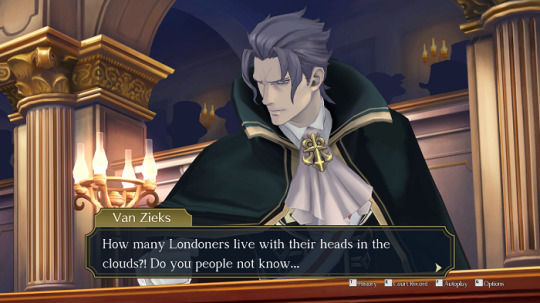
So he’s not only frustrated with McGilded now, he’s frustrated with the people of London for not knowing what sort of person McGilded really is. Van Zieks reveals he’s a dirty money lender who gained his fortune through corrupt means. He even takes the time to inform Ryu of this with the words “Your client is a shylock, sir!”
Edit: I feel a need to address this: shylock is a word with antisemitic roots. It originally came from a Shakespeare play involving a very bad stereotype. It later evolved to have a more broad meaning basically synonymous to loan shark and I think that’s the context the localization means to use it in. There’s absolutely no indication of McGilded’s religious beliefs and even if there were, I highly doubt the localization would use that sort of slur. Still, it’s a very unfortunate choice of words and is sure to accidentally sour Van Zieks even more with some players.
With that, the last juror votes, the scale tips towards Guilty and Van Zieks assumes the trial to be over. He thanks the jurors for their work. Unfortunately, once Susato brings up the Summation Examination, Van Zieks gets very frustrated again. This happens:

IIII don’t know what to do with this line. On first glance, I didn’t think much of it and was even willing to consider it was a compliment. Then I thought it must’ve been passive aggressive somehow; that it’s the sort of thing he wouldn’t believe until he’d seen it with his own eyes. A friend directed me to the notion that it might be referencing a stereotype that ‘Eastern women are fierce’ because they were associated with, well, certain ‘paid services’. I don’t think I need to explain, I’m sure you understand what I mean. And if indeed that’s what Barok is insinuating, that’s a new low I never thought he’d reach. However, when you’ve finished the games and know that Barok was friends with a married Japanese man, it’s entirely possible that he’s remembering a story once told to him by Genshin Asogi. So this is either a bittersweet reminiscence or the most scumbag association he ever could’ve made, but I’m not sure we can ever prove which it is.
Edit: As another option, it’s possible he’s referring to the Yamato Nadeshiko stereotype, if indeed it already held the ‘touch of iron’ aspect to it back in 1900.
He proceeds to toast his hallowed chalice to “the enigmatic East” and to be honest, I’ve once again got nothing. All I know is that he once again drew attention to the defense’s race when he didn’t need to, so… Scumbag point.
As a sidenote, in regards to the wine… I don’t count this as a humanizing trait. The same applies to the leg slam. These are animations meant to add some more lighthearted air and breathe more life into Van Zieks, so he doesn’t just stand there like a statue. They’re just quirks meant to have him stand out from other characters. So yeah, fun as the wine and leg slam animations are, they don’t count in the redemption requirements.
Anyway, Van Zieks mocks the age of Susato’s book, saying that judging by its bindings it must be fifty years old. Considering the context of the conversation, this isn’t out of bounds. The defense is using ‘outdated’ information on the law, so he points that out. Any prosecutor would’ve done it like this. Simon Blackquill likely would’ve offered to shred that outdated tome to bits for Susato. Van Zieks does toss in a “Hmph, typical Nipponese” later though, which earns him one more scumbag point.
Van Zieks continues to dismiss the Summation Examination, but the judge overrules him and allows it. Law is law, after all! And this is what I meant in my previous post when I said it’s satisfying to see Ryu use actual British law against Van Zieks. Ryu is using a perfectly legitimate technique to win the jurors over, and as Susato tells him, he can only do it by turning the jurors against one another with facts. He can’t appeal to them, he can only have them see sense. Which is difficult, because some jurors are more prejudiced than others:

… Yeah. Uh. Calling Ryu a “Dark Jinx” is pretty awful. Scumbag points for Juror No. 1! Meanwhile, Juror No. 4 keeps us updated on Barok’s actions throughout this trial:

Wow. Typical prosecutor behavior, though. Regardless, Ryu manages to win them all over in the end. With enough of the scales set back to not-guilty, the trial is allowed to continue, which leads to this:

Bye, hallowed chalice. A fun animation to keep things fresh and show us that the trial is about to take a turn. Once again, nothing new. We’ve seen prosecutors lose their patience before. What does interest me, though, is that Barok doesn’t direct physical frustration towards the defense. Remember: Franziska snaps a whip at Phoenix, Godot throws coffee at his head, Blackquill sends a hawk to attack the defense or uses that aijutsu slicing move, Nahyuta throws restricting beads… These were all direct physical attacks. Van Zieks, much like Edgeworth and Klavier, directs his frustration more inward and as a result he destroys his own property.
He succeeds in intimidating Ryu, though. Van Zieks explains that he kept silent, as is the norm during Examination Summation, but makes it clear that he considers it a charade all the same.

Van Zieks has been a pretty good gentleman towards the jury up until now, speaking to them politely despite that one remark about having their head in the clouds. Now that he’s seeing them ‘buy into Ryu’s stories’, as one might describe it, he’s getting frustrated with them. Maybe he’s even frustrated they’re choosing the defense’s side over his own.
He removes his cloak, entering what he says to be the next round of their ‘battle’. More typical prosecutor behavior, this. I’m not sure there’s an underlying thought to this, other than to indicate to the audience that ‘things have gotten serious’.
When the next bit of testimony is going on, I noticed something odd. Both Fairplay and Furst testify to having seen blood on McGilded’s hands, to which Van Zieks says:
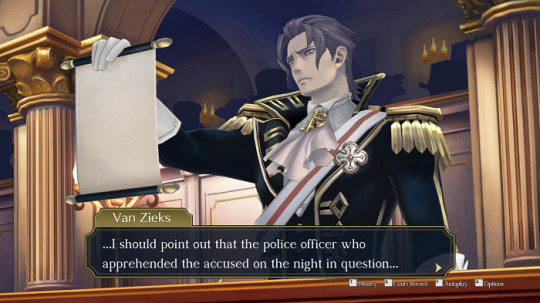
“... Reported that there was no trace of blood on Mr. McGilded’s gloved hands.”
So in a way, by establishing this fact, he’s helping the defense and going against what the witnesses are saying. It doesn’t help the prosecution in any way at all.
The trial continues on, with Van Zieks uttering things like “My Nipponese friend” and “my learned friend from the East” and lord knows what else… I suppose to soften the harshness of the original wording a bit and make Van Zieks just a bit less dislikable?
Edit: Tumblr user @beevean has pointed out that “my learned friend” is an actual term used in courts of law. There’s a tradition (also employed in British courts of law) that when addressing either the court or the judge, a barrister refers to the opposing counsel using the respectful term, "my learned friend". Of course, it can be said with an air of passive aggression and pretending to be respectful to the court while shamelessly disrespecting it is something Barok has always done, so the addition of “my learned friend” to the localization text is amazingly in-character.
Then of course we have:

This is both a scumbag remark and foreshadowing. Naturally, those playing the game for the first time won’t recognize it as the latter and therefore take it as nothing more than a harsh blow. Things spiral even further out of control when he starts talking about how people who claim the island nations of the Far East have a learning and culture of their own use those terms ill-advisedly. He also uses the words “artless backwater” and really, this is the low point of the trial right here when it comes to prejudice. Van Zieks is just plain lashing out with these sort of jabs.
Eventually, McGilded is dragged onto the witness stand to testify about whether or not there was another passenger aboard the omnibus. McGilded admits that there was, and Van Zieks snaps at him some more for using convenient excuses. Ryu is forgotten here for a moment. The whole smoke bomb thing happens, Van Zieks confers with McGilded and Gina in his own chambers, then the trial resumes. McGilded testifies, then Gina testifies… The jury votes not-guilty, buying into McGilded’s story about protecting a poor young pickpocket and Van Zieks loses it. He slams his heel down on the bench, pointing out that this is why he doesn’t like the jury system; because emotions are ruling where evidence and facts ought to be paramount. He points out while the cubbyhole Gina had been hiding in was empty now, it had been full of the coachman’s belongings during the police investigation. Someone tampered with the omnibus. This is where things get interesting, because Van Zieks addresses Ryu:

He’s giving Ryu the benefit of the doubt here. He’s offering an option for Ryu to be truthful about this matter. And that’s curious, because any defense attorney would naturally say what’s best for his client- or so it’s assumed. It puts Ryu in a difficult position for sure, but for some reason Van Zieks put the question forward anyway. The game responds as follows:

For the sake of argument, I attempted all three options. So when Ryu says he didn’t look, Van Zieks says: “Hm… Perhaps I credited you with too much intelligence.”
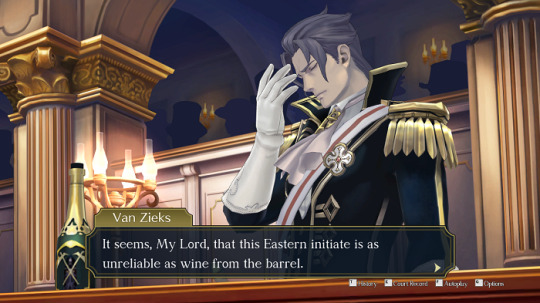
So when feigning ignorance, Van Zieks is kind of a scumbag about it. He is correct in his expectation that any attorney worth his badge would thoroughly examine the details of the evidence, but he didn’t need to be such a jerk about it. Now, when outright lying and saying it was empty, Van Zieks instead says:

The lines are very similar, which is an interesting note. It adds a feel of these responses being 'rehearsed', in a way. Just a default for him to fall back to. But the real kicker comes when Ryu tells the truth and says it wasn’t empty. Van Zieks is actually speechless at first with no more than a “...!” Clearly, he wasn’t expecting Ryu to respond like this. Everyone in court is baffled, McGilded gets angry… Van Zieks is a bit rattled now.
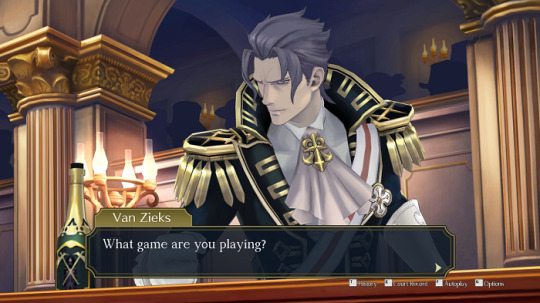
“Your task is to defend the man in the stand. Why would you say something to compromise his position?”
So really, it seems as if Van Zieks had only ever offered the question to Ryu with pessimistic intentions. He too had assumed there was only one answer the defense could give and was prepared for just that with his silly little wine analogies, only to be shocked when Ryu defies his expectations. Ryu confesses that he’s not entirely sure on where he stands in the matter, to which Van Zieks replies with “... Interesting.”
So now the jury members are doubting themselves again, with some offering guilty verdicts. Van Zieks decides to honor the ‘Scales of Justice’ once more now that they’re back in his favor, like the hypocrite he is. Gina testifies, Ryu points out an inconsistency, Van Zieks takes that opportunity to turn the tables back in his favor by implying Gina is a liar… He passive aggressively thanks Ryu for saving him considerable trouble and whatnot with some more “my learned Nipponese friend” remarks in there… Ryu turns the tables once more by insisting the victim came into the omnibus through the skylight, Van Zieks demands evidence and points out that furthermore, if indeed such a thing had happened, the witnesses on the roof would’ve seen it. McGilded hops into the conversation to imply that the witnesses themselves were the killers, which sends the court into a frenzy. Both Van Zieks and the judge shift the responsibility of the accusation towards Ryu, even though he never said a word to directly accuse the witnesses. Kind of a douchey move. Barok even states that Ryu’s ‘command of the English tongue must be wanting’, since

Yeahhh, that's pretty unfair. McGilded was the one who dropped that implication. However, since the judge basically accuses Ryu of the same thing, it’s a narrative choice to warn Ryu he needs to anticipate where his reasoning will lead him. Fairplay and Furst testify, pandemonium ensues. McGilded eventually gets what he wants when it’s revealed the skylight can open and there’s blood in there. Van Zieks once again turns his attention to McGilded:
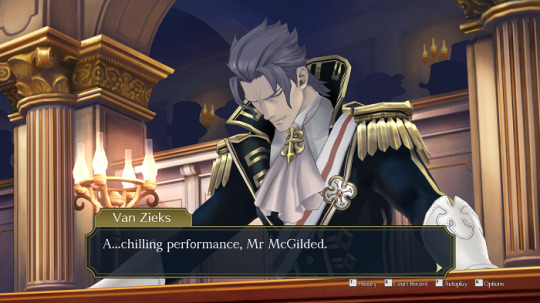
He knows McGilded is at the root of all this tomfoolery and evidence manipulation. McGilded is the real enemy here, in Van Zieks’s eyes. The conversation shows this by having Van Zieks point out that he’s well aware of McGilded’s involvement in dubious matters and that evidence is often ‘adapted’ to suit this guy’s stories. And now, once again, he turns his attention to Ryu. Once again, he’s giving the defense the benefit of the doubt:

The game gives you the illusion of choice here. If you choose to say it’s ‘out of the question’ that the evidence was tampered with, Ryu will refuse to say it out loud. If you say it’s entirely possible, Ryu will admit to that.

This is probably baffling to Van Zieks. It would’ve been so easy for Ryu to insist the tampering couldn’t have happened, but he doesn’t. The game won’t even let him. No matter what you choose, Van Zieks is clued in on the fact that Ryu doesn’t condone the deceit that McGilded is resorting to. But it gets even better, because a short time later, we get:
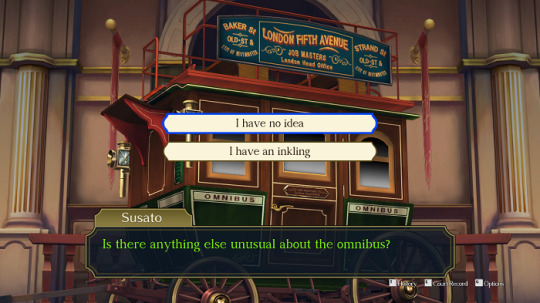
Another option to either draw attention to forgery, or to feign ignorance. Once again, I chose both options for argument’s sake, but having Ryu say he has no idea doesn’t get us anywhere. Susato will instead object to say it for him. With “I have an inkling”, Ryu says it himself. Van Zieks once again confesses, in his own words, that he’s caught off guard.

Ryu clarifies that he thinks the blood stain inside the omnibus is decisive evidence, but he can’t say for certain whether it’s genuine. McGilded loses it and by this point, is outright branding Van Zieks an enemy. Since the player at this point doesn't know whether McGilded is guilty or not, it leaves Van Zieks in a bit of narrative limbo. One might think: 'if the prosecutor is so intent on taking down a murderer, shouldn't we be on his side? Is he perhaps not as bad as he seems?' Unfortunately, McGilded points out that recollection and memories don’t matter, only evidence does. And… Well.

Which means they can’t rule on a guilty verdict and will have to let McGilded go. Van Zieks admits that he has no more witnesses or evidence to present. He’s out of options. As a formality, the judge asks the defense’s closing statement and we get one last option. Do we believe him to be guilty or not-guilty? When claiming he’s innocent, Van Zieks says:

It seems he means “abject” in the sense of “without pride/respect/dignity for oneself”, which… You know, is fair. By this point it’s very clear that McGilded is guilty, and since Ryu has already admitted that the evidence may be forged, insisting otherwise is indeed pretty spineless. Scumbag points to Van Zieks for continuing to draw attention to the fact that Ryu is from Japan, though.
Let’s instead just admit that we can’t say for certain McGilded is innocent. Unfortunately, we don’t see Van Zieks react to this, which is a bummer because this could’ve been very telling. The judge questions Ryu’s sanity (no joke) and McGilded laughs because it doesn’t matter; it was just a formality anyway. The judge scolds Van Zieks, saying that his case was flawed and it was his job to keep the evidence secure. Instead of objecting, Van Zieks just outright takes the blame for this and apologizes. Very interesting reaction, here. He stops pointing the finger to McGilded, he doesn’t attempt to accuse anyone else… He just admits his performance was flawed. Ryu tries to interject here:

(A badly-timed screenshot if I’ve ever seen one.) Ryu is making an attempt here to defend Van Zieks, the guy who has built up like 20 scumbag points by now. Ryu sincerely doesn’t hold a grudge against him. That’s very interesting. It doesn’t matter, though. The judge won’t hear of it, Ryu thinks it’s unfair, Van Zieks warns McGilded that this isn’t over and then we get the not-guilty verdict.

Hurray??? Profit??? It’s a victory that’s bound to leave the player feeling conflicted and jarred.
But after all’s said and done, we get one last cutscene to establish just how ominous Van Zieks really is. The omnibus is on fire, someone is inside and we know McGilded went into the courtroom earlier to investigate the omnibus in question. So really, by putting two and two together we can already guess what’s going on here. Van Zieks approaches the scene and watches silently.

It’s a good reminder to us that every defendant he prosecutes is ‘damned’ and he’s called the Reaper for a reason. Really puts the finishing touch on the eerie undertones of his character.
All in all, a pretty typical first time against a new prosecutor. Now I just want to draw attention to the fact that the first time we face Van Zieks in court… he’s actually on the right side of the courtroom and Ryu is not. Van Zieks presumably specifically returned to the court after those five years to target McGilded, as he knows about this guy’s shady reputation when it comes to ‘adapting’ evidence. Barok is 'cursed' in such a way that every defendant he faces is damned. So long as he stands as the prosecutor, McGilded can’t get away with his crimes. No matter how much forgery is done, the Reaper will go after McGilded and it seems Van Zieks was banking on this happening.
He likely also expected Ryu to have been bought off by McGilded; to say whatever’s convenient for his case. Turns out, Ryu is actually a man of integrity who’s invested in the truth and near the end of the trial, Barok has seen evidence of this. So what will happen next? We’ll have to play The Clouded Kokoro and find out! Stay tuned!
34 notes
·
View notes
Text
AIGHT Y’ALL I wasn’t tagged but I’m doing this anyways because f u c k i t
It's the year 2021 and you're obsessed with The Karate Kid. How are you feeling?
Deadasss weird as fuck, my dude. Like...out of all the things I could’ve predicted happening in our lord’s year 2021, it definitely was NOT getting hyperfixated on a hammy gay ship with a punk and a nerd from a goddamn karate soap opera. And yet...here we are??? I will never understand hyperfixations, my guy. But I’ve met a lot of really cool people in this fandom, so I can’t really complain.
Did you grow up with TKK or are you new to the series?
I have never seen a single Karate Kid movie in my entire life. When I was a kid, it looked kinda dumb so I never got into it XD But then I saw my roommate watching Cobra Kai on Youtube Red one day (he has every streaming service known to man) and I was hooked. And...here I am!
We gotta do the basics. Favorite character:
Literally EVERYONE except for Kreese, Yasmine, Kyler, and Tory, sorry stans
Okay but if we gotta pick, Johnny Lawrence is my Problematic Fave. Also I love my boy Daniel, he’s trying his best!!! And Amanda LaRusso, we stan a queen!!!
Among the kids, definitely Miguel, with Demetri as a close second. I also love Sam, Aisha, Moon, and Hawk (pre- and post-Bastardization Arc, anyways XD)!
Favorite ship:
Take a look at my username and take a WILD FUCKING GUESS lmao
Yes it’s Eli/Demetri because DUH, every interaction they have is so fucking gay and Eli fucking saved him!!! And came back to him!!! And betrayed the world’s most terrifying dojo with a WAR CRIMINAL SENSEI all for Demetri!!! And how Demetri was willing to forgive him for everything at the drop of a hat because he always had faith there was still good in his best friend??? That’s TRUE LOVE motherfuckers. Please let them kiss in Season 4. I will sell you all of my limbs.
Sam/Miguel is a close second because they’re cute as shit and it’s just so lovely to see two people so unapologetically smitten with each other. They are in LOVE, and I will RIOT if they break up again!!! Keep Sam and Miguel together 2k21!!!
Underrated character:
SAMANTHA LARUSSO!!! The amount of hate my girl gets for acting like a normal teenager and fucking up occasionally JUST like the rest of the cast makes me want to start punching things. She cares SO MUCH about her friends!!! And she loves the shit out of Miguel!!! She hasn’t always been the best friend but you know what??? Neither has Hawk, and we still forgave his ass!!! Also LET HER BE FEMININE but also kick utter ass, my god!!! Femininity should not be synonymous with being weak, y’all!
ALSO DEMETRI, like yes, he likes to complain and occasionally run his mouth, but guess what else he likes to do??? Never give up on the love of his life his best friend Eli Moskowitz and refuse to lose faith in him no matter how much of a little shit he’s become, and I for one think that’s very badass of him. Also the way he takes care of Eli pre-Cobra Kai in his own snarky bastard way makes me absolutely Weak and needs more appreciation. Like the dude has charisma and COULD have probably made other friends and left Eli behind if he wanted, but did he??? No, he wants the weepy loser with the lip scar in the polo shirts and dorky sweaters and will protect him as much as his wimpy ass is able!!!
Underrated ship (don’t say therapy, lol):
Among the adults, Daniel/Amanda!!! Like maybe I just don’t watch that much tv, but it seems kinda rare to me to see a happily married hetero couple, and it’s just nice to see a married couple who genuinely love each other and where there’s not like...lingering resentment or some shit. I feel like this ship gets overshadowed by Lawrusso a lot (which like--okay, fair!!! Daniel and Johnny do have a ridiculous amount of chemistry, and the gay undertones are undeniable, so I get it), and it makes me kinda sad. I do love Lawrusso, but I don’t like when Amanda has to get her heart broke for it to happen, you feel?
Among the kids, honestly YasMoon. Like I really love the idea of Yasmine trying to better herself because of Moon’s influence on her and because Moon like...inspires her to be a better person, I guess? With their pretty strong friendship, it just makes more sense to me for Yasmine to get a redemption arc through Moon than through Demetri. ALSO girls DO often pull the whole “mean girl” shtick to cover up being closeted lesbians, and Moon IS canonically bi, so it could work!!! I just think this one could be a really interesting Friends to Lovers take, and could make a really nice coming-out arc for Yas.
And MoonPiper too, honestly!!! Like they only got 5 seconds of screentime so I understand WHY it’s underrated, but I still love what we DID get and loved that there was a canon gay ship (even if only for 1 scene lmao). I’m really excited to potentially see more of them in Season 4!!! Please, I’m begging!!!
Wax On, Wax Off or Sweep the Leg?
Sweep the Leg because it will always be deeply hilarious to me how Demetri took note of the first move Eli ever used on him and spent presumably weeks perfecting it OUT OF SPITE just to get him back with it at the soccer game MONTHS later. Just goes to show how OBSESSED Demetri is with Eli and their little karate rivalry which is just NOT straight, I’m sorry
Which of Daniel’s dumb little outfits is your favorite?
There’s something so funny about this pretentious little fuck walking around in fancy suits once he becomes a #SuccessfulBusinessman, and still occasionally trying to do karate in a full-ass suit (take THAT, Tom Cole’s boba!!!) I’m also a big fan of how he looks in his gi with his little headband. Still killing that look as a 40-50-something!!!
Character from the films you most want to return, who’s not Terry Silver:
Tbh I have still never seen a single Karate Kid movie (they took them off of Netflix, RIP), so...I don’t really care if they bring anyone else back??? I’m invested in the characters we already have in the show, I don’t need some rando from the movies to make a cameo to have a good time XD The only character I really wanted them to bring back was Ali, and they already did, so like...I’m good??? That’s all I really needed, I can die in peace now XD
Scene that lives in your head rent-free:
Basically any fluffy Elimetri scene, but 5 in particular:
~Miguel first meeting Eli and Demetri at the lunch table, and Eli looking at Demetri like he hung every goddamn star in the sky
~Demetri going off at a terrifying, “unhinged” karate sensei on the first day of Cobra Kai because he made fun of Eli’s lip and Demetri is not about that shit
~ELI STEALING DEMETRI’S NACHO AND SMIRKING AT HIM, LIKE EXCUSE ME SIR PLEASE BE A LITTLE LESS HOMOSEXUAL IN FRONT OF YOUR GIRLFRIEND
~Eli yanking Demetri onstage during Valley Fest to hold a board, and Demetri being visibly like...extremely turned on when Eli breaks said board
~ELI SAVING DEMETRI DURING THE CHRISTMAS FIGHT, ELI APOLOGIZING, DEMETRI AND ELI KICKING COBRA ASS TOGETHER AKSBDCUWYVCBU
Will Anthony LaRusso ever be relevant?
I hope not! He’s kind of a funny meme character to pop up now and again but I don’t think he deserves a serious plotline when there are so many more interesting characters to follow.
You live in The Valley and are forced into the karate gang war. Which dojo do you join?
Miyagi-Do because Cobra Kai would eat me alive. Also I’d probably straight up get stuck and die in that cement mixer, if I even made it that far XD Besides, being salty that your friend who you have a crush on likes martial arts better than you and starting martial arts to impress them but also being too lazy to join anything TOO intense is a Big Mood and I am certainly not speaking from personal experience here, no sirree
What’s your training montage song?
"Shut Up and Drive” by Rihanna for a weight-training and bicep-flexing montage, “Whatever It Takes” by Imagine Dragons for a more intense punching-and-kicking-shit montage. I don’t know why this is, I just feel it in my heart.
It’s the crossover event of the century! Which TV show are you combining with Cobra Kai for an hour-long Saturday night special?
*Briefly panics because I don’t actually watch that much TV and most of the stuff I do watch is fantasy/sci fi shit that absolutely would not work for a CK crossover*
Hmmmm okay but ACTUALLY
You know what would be fucking funny as hell would be an It’s Always Sunny In Philadelphia crossover. Allow me to elaborate:
~The Gang goes to LA on vacation during the height of the Karate Dojo Wars. They literally can get barely anything done without all these goddamn karate-fighting teenagers getting in the way.
~They are all very annoyed by this. Even the most obscure of tourist attractions is eventually intercepted by karate fights.
~Mac tries to join Cobra Kai because he sees all this karate fighting on, and wants to unquestionably prove both his badassery and masculinity. Both Johnny and Kreese are like “Wtf are you doing here? Aren’t you like 30?”
~Mac gets a planet-sized crush on Johnny after all of 5 minutes and endlessly gushes to the gang about him. The gang mercilessly roast him about this and about how much of a pathetic loser with his life together in no way whatsoever Johnny sounds like. They proceed to have exactly 0 self awareness about this.
~The Waitress is in town visiting family or something, and Charlie is stalking her, as per usual. However, every time he’s about to go up and talk to her, a pack of battling Miyagi-Dos and Cobra Kais throwing punches and kicks everywhere blocks his path. One times, Mac is among one of these packs and Charlie is like “???? He didn’t get kicked out of that teen karate dojo yet???”
~Seeing how much the Kids These Days seem to like fighting, Charlie drops by a local high school to try and sell Fight Milk to the kids doing karate. Only Kyler and Brucks buy into it, and subsequently get the entire West Valley High wrestling team sick. Charlie is inevitably arrested, as Counselor Blatt thinks he’s selling the kids drugs.
~Dennis makes a plan to have sex with every hot chick he can in Los Angeles. He meets Ali on a dating app post-divorce, and inevitably tries to bang her. It doesn’t work.
~Frank crashes the rental car, and inevitably the gang ends up at one of Daniel’s dealerships. Dee quickly takes a liking to Daniel and is like “Watch, assholes--Imma homewreck this guy’s marriage.” She starts frequenting the dealerships to attempt to flirt with Daniel, until one day she walks in on him having sex with Johnny in a back room and she’s like “Is that the guy from Mac’s goddamn dojo?!?!”
~Dennis, of course, tries to sleep with Amanda. Amanda is not having it, and rebukes him in the most snarky, Amanda-esque way possible. Dennis is just like “Oh not AGAIN--the women in this goddamn diva city have too high of standards!”
~Later on, the gang is at the beach and Dennis spots the blonde lady he went out on an ill-fate date with, and decides to give it another shot--that is, until he sees her go up and kiss another woman and he’s like “IS THAT THE LADY FROM THE CAR DEALERSHIP??? STUPID-KARATE-KICK-COMMERCIAL’S WIFE?!? YOU HAVE GOT TO BE KIDDING ME.”
~Dee complains to Dennis about her lack of luck getting laid, and Dennis is just like “Oh come ON, is everyone in Los Angeles gay???” Smash cut to Hawk and Demetri having sex, Moon and Piper making out, Bert and Nate holding hands, Chris and Mitch doing oral, and Amanda, Ali, and Carmen having a threesome.
~Frank tries to scam Kreese into buying cheaply-made karate equipment for his dojo. The gang ends up having to leave LA because Kreese is quite literally plotting all of their murders.
For tagging, uuuuhhhhhh @jackonthelongwalk @soe-leo @max-eagle-fang @cc-tinslebee @backawayfromthegay @asphodel-storm do the thing, if y’all haven’t yet!
#cobra kai#cobra kai season 1#cobra kai season 2#cobra kai season 3#ck#tag game#binary boyfriends#daniel larusso#johnny lawrence#it's always sunny in philadelphia#iasip
25 notes
·
View notes
Text
So, I've wanted to address this topic for a while and this post I read this morning while having breakfast is a sort of response from the universe.
I would say to start by explaining a simple concept.
Demons and spirits are not the same thing, but rather, they vary from each other. Likewise, spirits and ghosts are not the same.
• Creatures understood as "demons" exist in all religions; they are supernatural beings, typically associated with the evil, historically prevalent in religions, occultism, literature, fiction, mythology and folklore;
• "spirits" are instead organized energy with at least a certain level of sensitivity that has an energy body and in most cases also an astral body. The Latin word is a translation of the Greek prneuma ("breath", "air", "vital breath") and to some extent it can be seen in the apeiron of the Presocratic Anaximander, who had to some extent dematerialized the archè (Greek: ἀρχή ) of the other Ionian naturalists, the original principle of the universe and of every part of it, impalpable and invisible but still material, as shown by another void that, blowing inside it, fills with air matter. With the Stoics, the term begins to be compared to today's one of spirit. The pneuma belongs to the god who gives life to things and guides them according to his wishes. The pneuma is a force that manifests itself not only in the individual man but is present in all things as the "soul of the world". They are ancient entities like the world itself, part of the primordial chaos and consequently neutral in themselves;
• the term “ghost” refers instead to any incorporeal entity. The term ghost comes from the Greek φάντασμα phàntasma, which in turn derives from φαντάζω (phantàzo, "to show"; from the root φαν-, which expresses the idea of "appearing" and "showing"), and had the meaning of apparition (understood as a supernatural manifestation) and only with time has its meaning been restricted to indicating the apparition of a deceased.
In 1800, with the birth of the practice of spiritism in France, it ended up rendering in the common imagination "spirits" and "ghosts" similar entities, if not true synonyms.
The French pedagogue Allan Kardec after observing a series of phenomena, formulated the hypothesis that such phenomena could only be attributed to incorporeal intelligences (spirits). Spiritual communications took place "thanks to the intervention of a medium", that is a person with particular skills who acted as mediator between spirits and living beings, during the so-called séance. This became a busines for many and most of the spiritualists were actually charlatans who swore to the victims that they could talk to the dead. In most cases, those who could afford to turn to a medium, were economically wealthy and of high rank lost and therefore for the scammer it was certainly not difficult to obtain information (even intimate) about the deceased and those around him, if at this was added some well-orchestrated play of smoke and lights, here is the "grandmother's ghost".
Having understood this, one wonders what it is then what we understand as a "ghost of a person". It is a trace left by the living. On a scientific level, death doesn't exist. From the chemical-physical point of view we are isolated systems that receive energy and produce it. But the universe itself is a closed system. So our energy is the energy of the universe. We are universe. What happens when we die? Our energy returns to the universe system. But as we know, energy is neither created nor destroyed, but it changes. So our energy is energy that has been changed in the past by others, and will be changed by others when we are gone. Death doesn't exist because energy is immortal. The energy that I am using now to tap on my laptop keyboard is the same energy that Gaius Julius Caesar used to pull the reins of his horse and to cross the Rhine. And it will be the energy that in the future a scientist will use to to be able to travel between the various space-time dimensions. Death doesn't exist, and the life of one is the life of all.
To simplify then, what we mean as the ghost of Marilyn Monroe for example, is nothing more than a sort of energetic gif of Marilyn Monroe.
I'll give you another example. Anne Boleyn died by beheading, therefore by a violent and unjust death. In this situation, she is likely to have felt strong emotions and released a huge and consistent huge amount of energy as a result. Let's say that Henry VIII was present at the execution along with a bunch of other people, let's also say that he went back to that place (or others where Anne felt strong emotions and therefore released large amounts of energy) and thought about her, let's say that Elizabeth I also thought of her mother and so many other people. All these emotions have turned into energy. If we saw energy as a palette of colors, it would be as if: the more consistent the emotions, the more intense the color, therefore, the more energy we send (even unconsciously) to the energetic image of Anne Boleyn (the energetic gif), the clearer this will be where most of the energy is concentrated (eg the Tower of London, a room in the building, etc.).
So when we go to a "haunted" place, what we see is not the "person", but a kind of still image. And according to the speech above, it is therefore normal to find this type of freeze frame in places such as castles, hospitals, etc. then if these are found on natural energy centers or lines… bingo!
Speaking instead of spirits, as mentioned before, there are no good or bad spirits. Good and bad as well as light and dark, like day and night, are a contrast present in many traditions, including native ones. This duality can also be referred to the human being and represent a moment of acting or thinking of a person. You can think and act towards the light or towards the darkness and this can also happen to shamans.
Just think of the ego and when it takes over, or when you try to manipulate, at that moment you are not in the light. But it can happen and that doesn't mean being good or bad. Acting, in fact, can also be connected with a person's karma and precisely follow what is required by this spiritual law.
Light and darkness, as in the human world, are also reflected in the world of spirits and even in this case they do not absolutely determine the condition of goodness or badness. Spirits, who in the light can be protectors, guides or allies, can also move in the dark dimension.
And if we think like the natives that everything has a spirit and that it can move between light and darkness, we can understand how there can be spirits that are particularly powerful and able to move very strong energies such as to create an effect in ordinary reality.
It is important to know the distinction between light and shadow because, from an early age, we were educated to separate the good from the bad, the right from the wrong, but for this we have become very sensitive when it comes to going to work on our shadows. As I told you, light and shadow are states of being that we all have within us. Working with shadows doesn't mean black magic, witchcraft or whatever. Simply observe the aspects of light and be able to deal with those of shadow as well. Light and darkness are two sides of the same coin that it is important to integrate.
Being half Latin, therefore leaning towards a culture extremely linked to its roots and above all to the relationship with mental spirits, it isn't difficult for me to understand this concept, and therefore despite being a Christian, I have no problem in defining myself as a witch. Of course, coming to this awareness wasn't easy, as I am partly European and therefore I grew up in a society in a Western society that is scared of what it cannot control. After years of researching my origins, my culture and theological studies, I have come to find my balance.
Returning, however, to the main reason for this post, having made the necessary explanations (and given the tools for a critical analysis of the matter), here are the points on which I personally disagree and why:
Reading books about witchcraft: Knowledge for educational purposes is by no means negative, quite the opposite. The question is whether the aforementioned "about witchcraft" book is a "spell book" or some sort of "sacred book". For example, if I find the Necronomicon tomorrow and start reading it without knowing what it is, it is likely that I will find myself living the remake of The Conjuring in the real life.
Casting most types of spells, including hexes: Same speech made in the previous point. One of the first rules of witchcraft is "know your practice". You must be aware that what you are doing is not a game and every action has consequences, even if you don't believe in the rule of 3 (everything you do comes back to you 3 times). In the specific case of curse and hexes spells, they are the most treacherous and dangerous, because you are working with dark and malevolent energies. This type of practice in particular is a double-edged weapon, which is why many witches advise against them and propose alternative methods if possible.
Practicing divination: It isn't always negative, but in some types of divination the help and guidance of spirits and divinities is sought. For example, I often do bibliomancy with the bible and even if I first ask for God's guidance, in front of each answer I ask for confirmation, because the devil was the most beautiful angel in heaven and just as darkness does not allow us to see. where we go, even a dazzling light can deceive us.
Playing with Ouija or other talking boards: Ouija is not a game and it is an extremely dangerous tool, precisely because what you do is contact spirits and entities and you cannot know who will answer the other side. Nothing good anyway.
Putting up fantasy or non-Christian artwork: Have you ever seen Annabel? Here, the principle is the same. Be careful what you bring into your home, as home is a sacred space, and nothing can enter without you giving it permission. So if you not only invite it, but rather you bring it inside and give it a space, don't come and complain to me if it is difficult to send it away.
Celebrating pagan holidays: If it's a holiday of a closed religion, avoid ruining your life. Holidays basically consist of performing rituals that often involve spirits. Learn about the history of that holiday you want to celebrate, the symbols, the rituals, and why it is celebrated in that particular way.
Celebrating Halloween: The same as the previous point, except that we all (or almost all) know that samahin is the day when the space where the veil falls and the two worlds come into contact.
Watching scary movies and TV shows: I'm not saying that if you watch The Exorcist you will be possessed, but I can't assure you otherwise either. I took The Exorcist as an example because it is known that a real ritual is performed in the movie and a lot of "disturbing" things have happened on the set of the film and to the actors. When you watch a movie, even if it is fictional, if for example it performs an evocation or a ritual you are not only witnessing, you are participating in all respects. Be careful, every person is different.
Reading (horror novels, fantasy books, comics and graphic novels). Playing (tabletop RPGs, LARP games, video games): Same as the previous point.
Listening to heavy metal music, dancing: It goes for any kind of music actually. Do you know how many pop songs I use as a spell?
Dyeing your hair: I'm not saying you'll invoke a demon, but for many cultures cutting your hair makes you more vulnerable to spiritual attack and color is an essential aspect of witchcraft.
Swearing: Wishing someone who has crossed your path death is considered a curse in all respects. Even if done unconsciously.
Drinking: Drinking, smoking… shamans have used alcohol and drugs for centuries to connect with in the spiritual world.
Having tattoos and piercings: As long as you don't tattoo Aramaic words that you don't know the meaning of, everything is fine. Before getting a tattoo in a symbol you saw in a temple in Mexico, find out the meaning of it. I'll give you an example: my cousin once bought a T-shirt with the words "puta madre" (mother whore). He had bought it only because he liked it, without knowing the meaning of the word.
Now, most of these points are mainly related to intention. As I said before, I often use music in my spells, but if for example, I use "can't be touch by Roy jones" for a protection and encouragement spell (eg a manifestation) and a few months later I listen to the same song on the radio doesn't mean it will work like a spell again. In many cases it is a question of intention. Yhat's why it is important to educate yourself.
#witch#christian witch#afro witch#green witch#witchraft#education#educate yourself#witchblr#witchy things#spirit#ghost#demon
15 notes
·
View notes
Text
The Goonies: A Product of the Times
Released in 1985, The Goonies came along right smack in the middle of a decade well-known for its movies centered on youth. While there are plenty of fond memories of the ‘teen oriented’ films like The Breakfast Club, Ferris Bueller’s Day Off and Adventures in Babysitting, Hollywood of the 1980s was focused on more than just the teenagers: it was also pretty heavily focused on what it was like to be a kid.
From Flight of the Navigator, The Explorers, and The Monster Squad to E.T., the Extra-Terrestrial, a lot of the films of the 1980s were about the adventures of people under the age of 14: children. Ranging from sci-fi to comedy, to horror, to adventure, the movies about kids during this decade of the new and untested were getting as big as everything else: more and more impressive as an entire subgenre of children’s movies starring up-and-coming child stars (Drew Barrymore, Fred Savage, River Phoenix, Corey Haim, and plenty more) sprouted up out of the ground, playing the gambit of genres and allowing children to act in ways that hadn’t been deeply explored before. These weren’t adult films with roles for children: a lot of these were movies about kids.
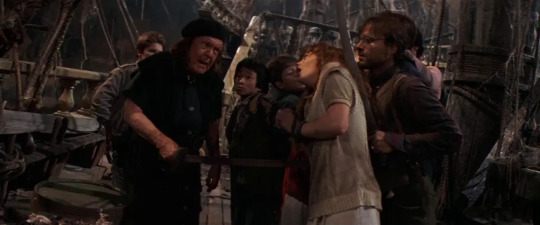
Instead of movies like The Champ or Aliens, starring children in side roles, films like The Goonies, Return to Oz, Stand By Me, and Time Bandits starred kids in the main roles, carrying the stories themselves with incredible performances, broadening the horizons for adventure films about kids, for kids.
Such is The Goonies, a film that really could only have been made in the 1980s.
How do I know that?
Simple.
As we’ve discussed before, no film ever made is separate from the culture it was created in. Every single movie, television show, radio broadcast, book, newspaper, comic or song ever made has been directly impacted by the culture and other pieces of media surrounding it.
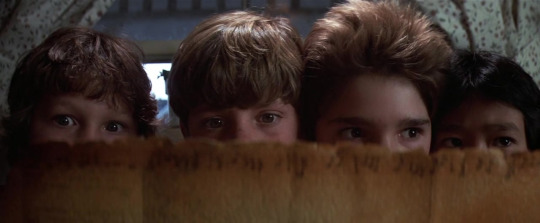
This seems pretty obvious: after all, a product made by people living in a certain kind of culture is going to reflect that culture. No film is an island, and while that seems pretty self-explanatory and without much need for discussion, in an era with more and more pieces of media debated as to their worth to a modern viewpoint, it leaves those of us who enjoy older movies with a very important question:
How ‘dated’ is too dated?
It’s not as easy a question to answer as it might seem.
See, ‘dated’ is an interesting term.

Typically, the word ‘dated’ is used to apply to anything discernibly created in a specific time period. It’s synonymous with ‘old fashioned’, when applied to a film, it carries the implication that the movie is less understandable by those looking from outside that particular culture or time period, worsened by the cultural drift. This would be a film that hasn’t ‘aged well’, most often describing contemporary films of the day. By contrast, a film that’s considered ‘timeless’ is the exact opposite: a film that remains completely understandable following a change in the culture. This is a film without a cultural footprint or identity, without any actual context, able to be enjoyed no matter how much time has passed.
These are words that get thrown around a lot in the film world. There are plenty of arguments over which films are timeless, and which are dated, whether Die Hard shows its age too much to be enjoyed, or whether Commando is too ridiculously ‘80s to be watched in any other context, but the fact is, the argument is a lot more complicated than it seems to be boiled down into.
We’ve talked a lot about definitions, but the fact is, by strict definitions, no movie, or any piece of media ever made, is actually ‘timeless’. Every film is a product of its times, but that does not mean necessarily that they are defined by their times. With this in mind, films like The Terminator and Predator, while set and made in the 1980s, are not exactly dated, because they are not defined by the 1980s. Anyone with the slightest understanding of the idea that times change can accept things like hairstyles, music changes, and special effects. Like I said, a film is considered ‘dated’ if it is less understandable or enjoyable in hindsight, from a place outside of that specific culture, and things like the movie tips and tricks of decades past are fairly easily forgiven.
Less easily overlooked are ideas.
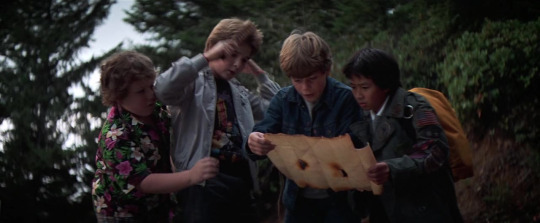
If a ‘timeless’ film is a movie not defined by its own times, then a ‘dated’ one is a film that is defined by its culture, typically in a negative way.
So, the question is: which is The Goonies?
Timeless iconic kid’s adventure film, or dated ‘80s flick?
Well, it’s kind of hard to say at first glance.

By externals, there’s no question. The way the kids are dressed and Mouth’s use of the word ‘gnarly’ pretty clearly set this film in the mid 1980s, as does the fact that nobody has a cell phone to call their parents. But as we’ve already established, there’s a bit more to it than that.
The cast is fairly typical of its day: all white except for Rosalita, the Spanish-speaking housekeeper, and mostly male. The two female Goonies do allow for a little more range than is sometimes portrayed in kid adventure films, with a Tomboy and Girly Girl dynamic that normalizes more than a standard Token Female per group, and even Mama Fratelli (although by no means a role model for young girls) balances out by being a memorable villain, bringing the gender ratio a tiny bit closer to even than a lot of contemporary films. With that said though, there isn’t really anything that I’d argue idea wise in this sense that dates the film terribly badly, aside from a series of fat jokes at Chunk’s expense and a moment where Andy is given the unfortunately expected treatment of having her date try to look up her skirt, which was considerably more shrugged off at the time (although she does get him for it later, offscreen).
And there are other elements too that indicate that this film is from a different time:
A PG in 1985 for a kid’s film was very different from a PG now, and it shows. The language used by a lot of the kids, as well as the violence, drug jokes, and other material has proven to shock more than one fan who went back to watch The Goonies as an adult. And that’s not all: the basic concept of kids banding together in this way, while making a resurgence in the form of Stranger Things, hasn’t really stuck around for very long.

After the 1980s, the ‘band of kids’ adventure story somewhat died out. By the 1990s, the ‘kid’ adventure stories calmed down, with lower stakes and less danger, and while the trope still appears in ‘retro’ nostalgia pieces, for the most part, we simply don’t see it anymore, and the idea still tends to bring to mind stories like Stand By Me, The Monster Squad, and even It.
It’s just a statement of fact, and not nostalgia, to look at this film and remark: “They don’t make them like this anymore.” Because they don’t.
In most movies today, kids don’t run around in tunnels, having a blast and looking for buried treasure without their parents or any adult supervision, with their lives in danger, all the while quirky, peppy music assures the audience that everything’s going to be okay. That’s not necessarily good or bad, it just means times have changed, and that the way that The Goonies was made was directly influenced by the types of movies coming out at the time.
However, while that style may bring to mind the 1980s, that doesn’t necessarily mean it’s specifically enjoyed in that era.
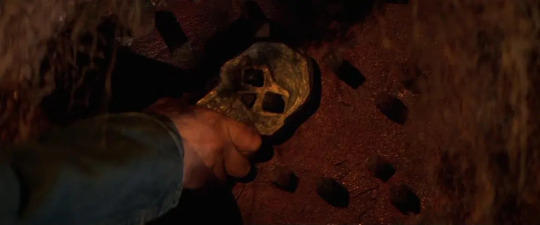
As a matter of fact, there’s a lot about The Goonies that’s like that.
The basic premise of the story, while not necessarily common anymore, is still understandable to people decades later. Just because we no longer dress or talk like 1985 anymore doesn’t mean that the core essentials of the film are rendered completely unrelatable. Kids still become friends and don’t want to move away from them, that much is understandable. Even though the style of filmmaking has changed, the characters really haven’t: we all know a Data, or a Mouth, or a Chunk, or a Mikey, sometimes we even are one of them. Kids understand the danger they’re in: not just losing their lives, but their homes, their friendships. These characters and their story still ring true decades later, even if there are things about it that point to its creation being set in the mid ‘80s.
In short?
No, The Goonies probably couldn’t have been made today. But that doesn’t mean it can’t still be enjoyed today.
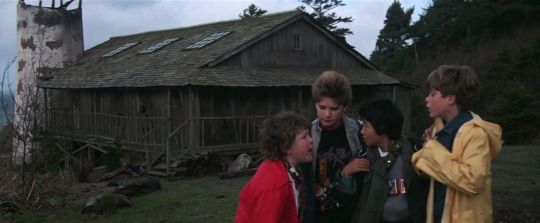
There’s surprisingly little that actually harmfully dates the film itself, and the film is, in many ways, just as exciting and fun as it was when it was first released. Honestly, there’s the possibility that due to the lack of movies like it made today, the film actually has a larger impact and is more unique and memorable now than it was in 1985.
And while the quality of the film has not shifted, as the time around it does, I think we’ll find that as the film gets older, more audiences will continue to discover it, forty, fifty, sixty years later and find that the movie still tugs at a nostalgic part of them and makes them feel like children again.
The Goonies is a fun, exciting, charming story that has remained beloved so long partially due to nostalgia, but also because people genuinely love the story and characters, proving that a film is ‘timeless’, not because you can tell what decade it was made in, but because it has endured, because people still enjoy it after the culture has changed.
If you can watch The Goonies and love these characters and enjoy their adventure, it doesn’t matter that Mouth is wearing parachute pants or that some of the character cliches haven’t been used in thirty years. In the end, a film’s quality has little to do with how easily we can tell what time the film was made in, and a lot to do with what it’s about, and how well people remember it. If that’s the criteria, then The Goonies is pretty timeless.

The Goonies has lasted this long as an ‘80s staple, and an adventure movie classic in general because no matter if it’s 1985 or 2085, people can understand it, enjoy it, and relate to the characters and themes. And that’s the reason it will continue to endure.
It’s been over thirty years since those kids first trekked into the caves to save the Goondocks, and the audience for this film has done nothing but grow since then. The characters and the heart of the film have gone unchanged since then, still entertaining and even touching audience members who remember what it was like to be a kid and want ‘their time’, and they will continue to endure for decades.
Thank you guys so much for reading! If you have something you’d like to add or say, don’t forget that the comment box is always open! I hope to see you all in the next article.
#The Goonies#The Goonies 1985#80s#1985#Film#Movies#PG#Adventure#Comedy#Family#Sean Astin#Josh Brolin#Jeff Cohen#Corey Feldman#Kerri Green#Martha Plimpton#Ke Huy Quan#Richard Donner
14 notes
·
View notes
Text
Brickclub 2.5.8, “The Mystery Deepens,” and 2.5.9, “The Man with the Bell”
Valjean contemplates the sleeping Cosette, and has an epiphany, or thinks he does:
“He clearly perceived this truth, the bedrock of his life from now one, that so long as she was there, so long as he had her by him, he would have no need of anything but for her sake, nor fear of anything except on her account.”
This is going to be literally true, and if Valjean were actually in that place of clarity where he thinks he is, I might say that he’s recognizing that he’s already dead, and merely allowed to keep existing for Cosette’s sake.
But he’s not. @everyonewasabird points out that this is where Valjean makes his fundamental error:
He thinks he has his clarity of mind back.
But he doesn’t! He doesn’t even know he’s cold!
And here, (HERE!?) we get the thesis of the rest of Valjean’s life. Everything revolves around Cosette, she is his sole purpose, and his continued existence is synonymous with her continued proximity.
That’s going to be a problem! She’s going to meet a boy one day, and Valjean will literally die of it!
And there’s always been this question in my head, of what error does Valjean make, and when does he make it?
And the answer is: he makes it RIGHT HERE. In this dead place, thinking he’s clear of mind when actually he’s nothing of the sort.
If we didn’t get that point clearly enough, we soon learn that his calm reassurance comes from contemplating a child he thinks is sleeping who is actually close to death. Cosette in this moment is one more thing that seems like a true light to follow that actually conceals a tomb.
It does feel like there’s some magical bargain being made here. The certainty he feels gazing at Cosette seems almost like a prayer--as long as Cosette is safe, he won’t ask for anything, or need anything for himself.
Valjean is starting to subconsciously notice Fauchelevent’s bell, and after this he’ll notice it properly and be cast back into an immediate and justified terror for his freedom. And he is still terrified by the sight of the prostrate nun--which is fascinating. As much as Hugo is laying on the Gothic horror, why is the nun the most terrifying thing Valjean has ever seen? He’s been in the bagne! Twice! He’s seen some shit. What about the nun performing the reparation is so existentially terrifying?
Even after he finds out where he is and what that prostrate figure was doing, he’s still going to be Weird about it. Later, he will kneel and pray just outside the chapel wall, contemplating the sister at the post, the way he knelt on the doorstep of the Bishop of Digne, and the way he approaches Fantine and Cosette as figures of worship.
He doesn’t know yet who the nun is or what she’s doing, but the echoes of that tendency to set up intermediaries between himself and the divine has some really interesting resonances with the conversation with Fauchelevent.
“Père Fauchelvent, I saved your life.”
“I was the first to remember it,” replied Fauchelevent.
“Well, today you can do for me what I once did for you.”
Fauchelevent took in his old, wrinkled and trembling hands Jean Valjean’s two sturdy hands and for several minutes seemed unable to speak. Finally he exclaimed, “Oh! that would be a blessing from the good Lord if I could pay you back a little! I, save your life! Monsieur le Maire, this old man is at your service!”
A wonderful joy had in some way transfigured the old man. His face seemed to radiate light.
As Bird pointed out, the conversation at the end of the chapter where Fauchelevent calls Valjean an ingrate for saving his life and forgetting him--and implicit in forgetting, not giving him an opportunity to return gratitude or service--recalls “Enjolras and His Lieutenants,” the other big non-Marius-related use of “ingrate” in dialog. And this scene recalls OFPD--the handclasp, the moment of transfiguration.
And this scene goes well, mostly? Fauchelevent gets to save Valjean. Valjean gets the help and the refuge that he needs. And he gets a friend--he makes the one human connection outside Cosette that we’ll ever see him make.
And yet the fact that it is the only one really suggests that something here is still broken. There’s a lesson he’s not learning, or at least not able to apply ever again. He will be in this position again, face to face with a person whose life he has saved, twice again and he will fail to make a connection with Javert and do everything in his power to thwart making one with Marius.
I’m not sure exactly what the lesson is, but there’s something here I can’t quite put into words about how saving or transforming a life creates a mutual obligation. We’ve just seen Valjean gaze at Cosette in worship, without waking her and without, at least at first, understanding what she needs. And we’ve seen him run in absolute terror from a figure who he will later turn to with that same worship. But we’re never going to see him reach out, the way Fauchelevent does, to anyone of the people who have transformed his life and try to meet them as equals, or to ask whether worship is what they need or want of him. And he’s going to spend the rest of his life making sure that no one else he helps, no one he saves, has the knowledge or opportunity to reach out to him.
15 notes
·
View notes
Text
The Offspring of a Dream
Fandom: Bloodborne
Fic Summary: Why does the Doll call you “good”?
Notes:
Obviously the lore in this game is very hidden and up for interpretation, so this fic in part has to do with my personal interpretation of things, so please keep that in mind!
I know there's a theory about the Doll being a Great One/Avatar out there (haven't read up about it much through), but currently I find there's something rather beautiful about the Doll truly just being a doll, who is genuinely kind, and just trying to help us out, because the game has little to no other characters like that.
I also know whether or not we are "good" is definitely up for great debate, but I'm the kind of person who likes to see/read redemption into everything, so this is just my rather optimistic interpretation of events.
Also, I don't necessarily ship the Hunter and the Doll, but I do think it's a cute ship and enjoy content for it...So you're free to interpret the internal monologue as platonic or romantic, whichever you prefer.
This is one of the only times I've used second person, so go easy on me...I chose second person because I didn't find third or first nearly as compelling for it.
I'd really really appreciate it if you could leave a comment!! They seriously do make my week, and give me the motivation to keep writing!!
I also have another Bloodborne fic about Vicar Amelia's transformation, I'd love it if you could check that out too!! Links in a reblog!!
The Offspring of a Dream:
“New Hunter”
“Mister Hunter”
“Hunter”
“A Hunter!”
“Moon-Scented Hunter”
“Miss Hunter!”
“Good Hunter of the Church,
"have you seen the thread of light?”
“Welcome home,
Good Hunter.
What is it you desire?”—
No name.
Not a greeting, nor title.
No adjectives or addendums like ‘holy’ or ‘accursed,’ ‘beast,’ or ‘man.’ Not a crow, or a wolf, or an avenger, or a knight. Nor a roar of what you hunted.
A lonely hunter without a name, or a word.
Just a hunter, who may or may not be good.
And it was a doll, a doll who had a dreamer, but was equally lonely—
Is this all in my mind? Did I dream her up?
It was this Doll who said you were good, every time you arrived in the dream, always ready to turn your desires, the echoes of a scourge, into strength.
She said it faithfully, and it was not easy to recognize when she said it, it wasn’t a greeting, or a title.
It was a prayer.
Because she had watched a thousand “good hunters” walk through the dream, and a thousand fall. A thousand keep her company, a thousand ask for her to make them stronger with the echoes of their killing. A thousand become drunk with blood, trapped in a very different dream, that some might call nightmare. And a thousand become something other than a hunter…something other than good.
A thousand graves.
Graves for the ones who woke up.
So with a title she prayed to the moon that this one—this one—would be good.
That’s all she needed. That’s all any of them ever needed; one good man.
The title ‘hunter’ was meant to be synonymous with good. A force of holiness to purge the impurity. …But their name became equivalent with evil. Or maybe it was from the very start.
The spreading corruption burned.
Before the blood parched their lips and ravaged their bones. After. At the end of the day, we’re all human. At the end of the day, we’re all beasts.
Born of the blood… undone by the blood…
So she—inhuman, human—she prayed that one day there would be a hunter who could fight the monsters and not become one. That the blood wouldn’t burn and coil and wrap its tendrils around them, twist them inside out, and make them something more than just a “good hunter”…and so much less. She cast goodness over you, as if reminding you not to give in to the beast. Not to give in to your humanity. Reminding you that though you were a hunter, though you were drenched in blood, with heart full of holes, and brain full of eyes, you could still be good.
She put her hands together and she prayed. She prayed, and she helped you on your journey, she channeled death into strength, she whispered, and she tended to frail, living flowers, and feeble, dying, old men, and she cried.
Any god-fearing man, not burdened with an overabundance of naiveté, would know that dolls don’t whisper. They don’t ask if you love them. They don’t move. They can’t help. They don’t pray. And they definitely don’t cry.
Dolls sit lifeless on the floors of children’s nurseries, and the abandoned workshops of bitter, maniacal, old men.
Is this just a dream? Will I know you when I wake?
What’s waking worth without you?
If the gods don’t love me I still promise to love you.
You watched human hands twist into claws, skin into fur, faces into tentacles, tongues into snakes, and eyes into eyes, and wondered if perhaps this doll, with her porcelain skin and hair, with her tears and prayer, if she was more human than the rest. This doll—who asked about gods and love, who cared for you, who hoped even the worst hunters might be worth something in another, better world—was more human than the offspring of an old, forgotten town. More human than we, who are born and die by the blood.
How was she born, and how would she die? What caused her to breathe, to come alive? Was it just our minds, some ill-gotten, internal eyes? Was something so primitive as hope or love? Or was it the twisted will of some faceless moon without a man in it?
Is it just me?
Is it my mind?
Tell me she’s more than children’s toys, and old men’s dreams.
Tell me she’s real.
Could something made of metal and mechanics, and the puppet strings of our own minds die?
Do dreams die when we wake up?
Or, in the end when men are all either monsters or gods, would she stand in the wreckage, the only real, awake thing left…the only thing left that’s still human?
When men become gods, do our creations become human?
She watched them fall. She watched them reach for bare threads of guiding moonlight with human hands, and howl at the same moon with a wolf’s cry, and she still had enough hope left in her to call you “good hunter.” To believe that you would be different.
Did she say this to everyone? Did she hope every time? Or was it just you? And which meant more? If she hoped despite just how many had failed, or if she saw something different within you alone?
Here you stood, steeped in the blood of beasts. Ugly thing. Killer. Cold and merciless.
And she called you good.
Did that mean she saw the blood, and the murder, and thought it was good? Or that she looked past all that and saw the good still?
How could she, a doll, an echo herself, know what it meant to be good?
Perhaps she was made by someone who had seen a world with good left in it. Or a world which was evil, but in which there was someone like her, who encompassed all the good in the world to him.
Perhaps that’s what she was to you too. The good. The human left. Without her you may never keep fighting. You had no one else, after all. Your friends were either mad, or intoxicated, or destined to die, or destined for…worse.
Is she just a trick of the moonlight?
She was the embodiment of hope.
You tried to be good. For her. For the world. They all did. But most became drunk on blood, or knowledge, and lost themselves along the way.
What is it you desire?
It always starts good. Goals, on paper, always seem so noble. In practice, so bloodthirsty.
Laurence made a church. A force of holiness and healing. And he turned the city into a madhouse, a cage for monsters.
Wilhelm made a school. A place of mindfulness and learning. And he dabbled in rituals to hide the moon.
The old hunters thought stealing a child wouldn’t incite the wrath of its mother.
They all thought the world could be saved, that the plague could end through quarantine or amputation.
When they cut off the diseased heads the blood only spread. When they stayed in their houses they went insane instead.
The world needed more than a simple fix to return to being “good.”
The hunters thought they were fighting for a noble cause. They thought they were all good…and they turned into the very beasts they fought, awaiting another hunter to spill their blood, and start the cycle again.
The hunters only did what they could; keep killing. That was all they knew to do to get rid of the the beasts in this brick forest.
They needed a hunter who would break the cycle. Do more than just kill and give in to the call of the blood. Who would seek the paleblood, and end this dreadful night.
Transcend the hunt.
But how to eclipse the chase when evolution without courage is the name of ruin?
A hunter who would look beyond today’s night, today’s hunt, today’s beasts. Beyond the blood. Resist its seduction. A hunter who could learn where all this started, find it. And do what hunters do best:
Kill it.
—(For sometimes death is freedom, at least when it’s a dream)—
Seek the paleblood. Hunt the great ones.
—(And sometimes waking up is far worse.)
The formless blood wanted to have a child. Perhaps he thought he was giving those he chose a gift of a sort. Only horror followed.
Every great one loses its child.
One particular woman, long ago, held the name of this broken town. Perhaps it was only fitting that the child of blood and name was born in voice alone.
This child’s formless cries echoed through more than the nightmare; through the waking world—(if you had enough eyes, at least)—calling you to comfort it, to silence it.
Could everyone in the town hear it? Is that what drove them mad? Listening to a child’s endless cries, with no hope of comforting it?
Many had tried to contact it. Some tried to become gods…and misplaced their minds in the process. But you found it. Knowing it was not to be exalted, but destroyed.
You were a hunter after all.
So you killed the only thing keeping it alive, the thing desperately trying to play a lullaby and sing it to sleep.
You yourself played a tiny music box for it, from the beginning of it all—that belonged to a family ravaged by the blood, the hunt, which held a song about love and loss—just to hear it laugh, before the nightmare let out it last.
Cords of thirds. Cords of three.
One from the child of voice. One from the child of night. One from the child stolen long ago, sitting in an old, abandoned workshop.
A workshop alive now only in hunters’ dreams.
You could have left your own nightmare long ago. You could have woken from this dream and believed the world was not so dark, not so strange, not so fascinating.
But this wasn’t the only nightmare you had to liberate.
There was another, another for which all not-so-good hunters were destined—(and thus you too if the Doll’s prayers were in vain). They sent you there with a piece of a drunken man before you yourself became, inevitably, intoxicated, in this bloody bar, so that you could, perhaps navigate sleeping minds with your sanity in tact.
We, the offspring of an old, forgotten secret. Destined and bound by the chase.
So our forefathers sinned?
Ludwig thought he was holy, fighting for a noble cause, and he stood, accursed, in a bath of the blood he spilled, trampling the ghosts of those he killed.
Is it possible there exist moonlight in even the darkest nights?
When we reach for the thread of light, none of us ever want to know what it truly is. Hope can be so vicious that way.
The church turned their eyes from their hands.
All too often, when men try to become gods—or something akin—they become monsters. There's a reason the moon is out of our reach.
Laurence thought the blood would heal. That the gods wouldn’t mind a little thievery. He thought they could keep their humanity in tact, as long as they prayed hard enough.
And he watched the world burn. Watched his hope turn his universe into a waking, walking nightmare. And he burned in his own broken Neverland, ever searching for his own lost, rotted humanity.
Maria, beloved apprentice Maria—
…Is that you, my dear Doll?
Who was there from the beginning. Who vowed to forsake the blood—including her own. Maria, so sickened by her actions, who threw the hunt down a well. Who vowed to in death to be the hunt’s secret keeper, and sat, alone, a lonely princess at the top of the clock tower, alive by the puppet strings of a nightmare—
She sacrificed herself, her values, to purge you from the plague of wild curiosity.
A corpse should be left well enough alone.
And at last, behind time, was a quaint, sad, little village, that lay dripping with secrets, ransacked for its eyes.
A quaint little village where it all started. Where the sky wept, and sun collapsed in on itself, and the great lake held too soft and depraved a secret.
Every great one loses its child…but this one lost his mother.
A quaint little village where a sympathetic mother fell from the stars. Where her child was ripped from her, dissected for parts, by the very people you once thought were good.
The wrath of an angry god is to be feared. But the wrath of a sympathetic god is far worse.
And the wrath of a mother is a lasting curse.
Death is freedom, at least in a dream. But when waking up is far worse, we rewrite the past within our dreams.
This was an orphans dream, pulling the hunt into a nightmare, as he waited to be freed from reality, as he waited for a hunter to rewrite the sins of their ancestors.
As he waited for a good man.
And the spirit thanked you. And the hunt thanked you.
And the Doll thanked you, for a shackle she never even knew was there had been lifted. She thanked you on behalf of the first hunter, for he slept a little sounder.
But there was one last dream that needed slaying:
Your own.
You could have woken long ago. You could have forsaken it all for the sunrise, and left someone else to find the answers, left someone else to be good.
It would have been nice to believe the world made sense.
It would have been nice to believe the dark side of the moon wasn’t made of blood and bones, haunting a poor, old man.
Few dreams offer you the choice to die before the bad part starts—(or perhaps simply to put an end to all the ‘bad parts’ you’ve gone through, to negate the possibility of more). But you would not bow to a happy, false reality.
Neither would you allow yourself to be taken captive by the nameless presence of the moon, made to perpetuate this hunt endlessly.
You understood the word “hunter” was never synonymous with good. They lost that title before the hunt even started. They lost that title when a little orphan was stolen from his mother.
You understood at last. It was her. Maria. The one who threw her weapon down the well in protest. She—(or at least, a version of her)—stood by your side, trying to guide you back all this time. Trying to guide you back to the beginning, where perhaps her sins could be atoned for. Where perhaps there could be good still.
So in a lonely field full of flowers, it was not you who were released from the dream.
You had enough eyes to see and slay the presence of the moon, who had orchestrated this all.
We’re all just puppets of the moon.
…But a cord of three strands is not so easily broken.
So in the end you neither woke nor dreamed, but saw the world as it was—though through newborn eyes. A child of the hunt. A child of the dream. Not destined to create a nightmare…but perhaps a better reality.
When the Doll picked up your small body, she smiled at last. She knew you’d succeeded, for this was unlike any hunter’s death, or transformation, she knew. She knew you’d atoned for the sins of your predecessors. She knew you’d freed the children, the nightmares, and the men.
And she called you “good hunter” still. For she knew the gods listened to her prayers after all. She knew that though you were a hunter no more—
You were certainly good.
#bloodborne#bloodborne the hunter#bloodborne plain doll#bloodborne fanfiction#plain doll#bloodborne fanfic#bloodborne fic#bloodborne the doll#bloodborne doll#bloodborne video game#bloodborne fandom#mergo#orphan of kos#moon presence#gherman#lady maria#laurence the first vicar#provost wilhelm#bloodborne dlc#bloodborne old hunters#bloodborne old hunters dlc#video game fanfiction#video game fanfic#video game fic#writeblr#fanfiction
80 notes
·
View notes
Text
Fantasy space
Spelljammer is a cool setting. Unfortunately, it was first written in 1989, for 2E D&D. I'm not going to require anyone to read old sourcebooks, even if they're really cool once you remove the old-edition-mechanics from them, so here's an overall summary of how it works. Additionally, there were some things I didn't like in "official" Spelljammer (like clerics not being to regain higher-level spells in a different crystal sphere), so it just makes sense to write out my version of things.
(To clarify: everything I put here is consistent with “official” Spelljammer, to the best of my knowledge. If there is something I didn’t like, then I simply did not include it. There are also other things which I did like, but I did not include here because they were too specific for a general overview, or because I forgot.)
1. Fantasy space follows different rules than real-world space
We're not playing a sci-fi game, we're playing a fantasy game, after all. I'm putting in a brief summary of everything here, so hopefully it will make sense. Further sections give more details.
Planets happen inside wildspace, which is kind of like space-space but it isn't a vacuum. Each planetary system, with its planets and wildspace, is encased in a crystal sphere. The various crystal spheres are surrounded by the Flow, which is flammable and also prevents dimensional travel.
When in wildspace or the Flow, everything has its own air envelope; the air inside this will not vanish, but it will get used up and go bad. The larger the thing, the larger the air envelope. Large enough things have their own gravity, and the effects of its gravity reach as far as its air envelope.
2. Wildspace
Wildspace is what you get between planets. There is very little there, other than asteroids (which may or may not be inhabited), other ships, and wreckage (which may or may not have already been picked over). Most space travel happens in wildspace, because the things to travel between are closer together.
You will not die from imploding if you are thrown unprotected into wildspace. You will however probably die from suffocation once all your air has gone bad, since wildspace does not have atmosphere, but you will have some time to be rescued or find air before that happens.
3. Crystal spheres
A crystal sphere contains a planetary system. Inside of it are planets and wildspace; outside of it is the Flow.
The shell of a crystal sphere cannot be damaged by any known means. If you want to get through it, you need an opening. These openings happen naturally, and they seem to be at random. If you do not want to wait until an opening happens nearby, you can use magic to make an opening happen where you are. Sometimes this magic is built into a ship, but that makes the ship more expensive.
4. Phlogiston / the Flow
(The "proper" name is "phlogiston", but I'm going to call it "the Flow" because a) that's easier to write, b) it is synonymous in the sourcebooks, and c) I don't know how to pronounce "phlogiston".)
The Flow is what you get between different crystal spheres. It is luminous and rainbow-coloured, and also extremely flammable. If you light a fire while your ship is in the Flow, you're going to have a bad time. If you light a big fire while your ship is in the Flow, like if you're trying to cast Fireball, you are going to have a very bad time. Even if you're fireproof, and if your ship is made of things that don't catch on fire, chances are that your friends and your cargo are not also fireproof.
The Flow provides as much light as an overcast day. This is good because if you need to see, you do not want to light a candle or a torch if you enjoy not being on fire.
The Flow prevents any dimensional travel or access. If you have a Bag of Holding, you will not be able to access its contents while your ship is in the Flow. You will not be able to teleport, go ethereal, or summon creatures from other planes.
The Flow can preserve things. If you run out of breathable air while in the Flow, you go into suspended animation, and then wake back up once you have proper air. This preservation only lasts while in the Flow. Sometimes there are ships floating around in the Flow, where all the ship's air has gone bad, and everybody on board is in suspended animation. They could be there for days or months or years or decades, and nothing would change for them. If you have to be thrown off your ship and left adrift, try to have it happen while in the Flow. You will start to suffocate as your air runs out, but it will not kill you.
The Flow has its own currents. If you know them well, or are lucky, you can arrive somewhere faster than anticipated. If you make a mistake, or are unlucky, it could take you a very long time to arrive.
5. Gravity planes
If something is large enough then it will have its own gravity. "Large enough" in fantasy space is significantly smaller than you might think. Gravity points "down", instead of "towards the centre" (unless you are dealing with a spherical planet).
The larger something is, the farther its gravity will reach. If two different large objects come close enough that their gravity fields interact, then the gravity angle of the smaller object will change to match the gravity of the larger object. This can be extremely inconvenient if the two objects are ships, you're in the smaller ship, and "down" is now "sideways" and everything has fallen all over the place. Because of this, if two ships come near each other, the smaller one will generally turn so that its "down" is pointed in the same direction as the larger ship's "down".
Gravity in fantasy space is a yes-or-no kind of thing. You are either within something's gravity field, or you are weightless.
6. Air envelopes
The larger something is, the more air it carries with it. If you go in space just with your own body, you will have enough air along to survive for a little while, but not for as long as you would probably like. If you go into space with a large object like a ship, there will be a lot more air.
The air around something is called its air envelope. The size of an air envelope is the same as the size of its area of gravity, if it has a gravity field. If you can fall, then there is air available, even if that air might have gone bad. Things that are too small to have gravity still have an air envelope, but it is smaller than the air envelope of something that is large enough to have gravity.
When you breathe, you use the air in the air envelope which you are in. If the air envelope is small, then you will run out of usable air sooner than you would like. If the air envelope is large, then it will not be a problem for a long time. A ship generally has enough air to last its crew and passengers for a couple weeks or months, depending. If there are more people in an air envelope, the air will go bad faster. If there is a fire in an air envelope, the air will go bad faster.
There are ways to keep the air fresh for longer, some of which are plants and some of which are magic. It is possible to have it so that the air never needs to be replaced, but usually something goes wrong along the way.
7. Ships that travel space
"Officially" they're called spelljammers, but I just call them "ships".
a) Helms
Space is large [citation needed]. Normal ways of getting from one place to another, even very fast ways, are impractically slow when it comes to travelling in space. There are several ways of powering a ship fast enough to make space travel feasible, but helms are by far the most common. A helm gets a ship to go fast and also gets it to go where you direct it to go (which might not always be where you want it to go, but that is why navigators are a thing).
A helm is a chair with ship-go-fast magic added to it. It can be transferred between ships, which is good because it is expensive. In order to use a helm, a spellcaster sits in that chair, and that both powers the ship, and lets the spellcaster mentally direct the ship what to do. This uses up their magical energy for the day. A spellcaster can only helm a ship if they're full up on magical energy before they start.
Helms are designed so that a ship will automatically slow down from space-travel-fast when it approaches something large enough that it would hurt if they collided. You can still run into things, but it will be at a speed where you have time to try and move somewhere else if you want.
b) Ship varieties
There are many different types of ships in space. Some of them aren't able to go space-travel-fast. These are mostly used to go short distances, like to transport stuff between big ships and places where the big ships can't land, or for space combat, when nobody can go space-travel-fast anyways. These are generally smaller ships that are more agile, but they can also be larger ships where someone didn't or couldn't put in a helm.
Many ships in space look like a cross between a water-ship and a fish or insect. This is because that is cool. There is almost always an open deck, since air won't escape the envelope, so there's no reason to close everything in.
These are a couple of different things people might want in their ship, which is why there are so many different designs:
more storage space
more agile
harder to damage
more weapons
needs fewer people to crew it
able to fit into more places
able to land on ground or water
fits someone's standards of a good-looking ship
easier to repair
costs less money
((Black lives matter, and trans rights are human rights.))
((Also posted on Pillowfort, here.))
41 notes
·
View notes